

Austin was one of the few remaining major cities in the United States that I hadn't visited prior to this trip. Known in earlier decades largely for being the capital of Texas, Austin has emerged in more recent years as a thriving city in its own right, with a distinct local culture emphasizing live music performances and the arts. This city has also become a major corporate hub with big tech companies like Facebook, Google, IBM, and Intel placing their regional or national headquarters in the city, drawn by the low taxes and weak labor regulations present in the state of Texas. Austin has been booming in population thanks to the arrival of those big companies, with the population of the city essentially doubling from 1975 to 2000 and then projected to double again from 2000 to 2025. This is the 10th most populated city in the USA going by incorporated city boundaries although the more accurate greater metropolitan area rankings have it somewhere around 25th place at present. In any case, there was no shortage of things to see and do around Austin in the brief time that I had to visit.

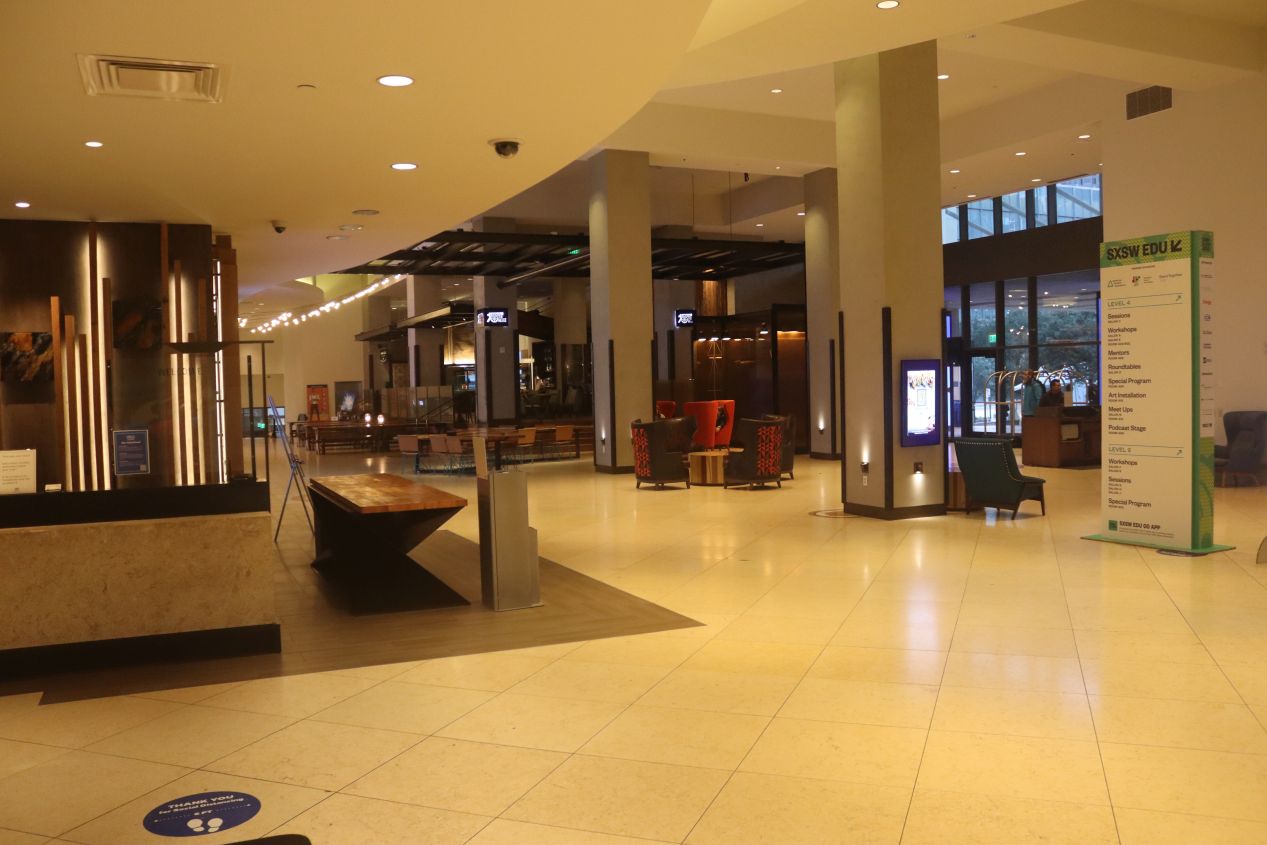


The specific reason why I was traveling to Austin was part of a work trip for my wife Liz. She was taking part in the South by Southwest conference (SXSW) that takes place each year in Austin and draws huge numbers of visitors to the city. This was the Education portion of South by Southwest, not the more famous versions dedicated to music, film, and new technology. The education portion took place a week earlier than the main part of South by Southwest and drew a smaller number of attendees. This 2022 rendition of South by Southwest was also smaller in scale due to the COVID-19 pandemic after the event had been all-virtual in 2020 and 2021 due to the virus. Liz was tied up at the conference for two full days of events while I was able to tag along and spend that time sightseeing. These are some pictures taken at our hotel, the Hilton Austin, which was connected to the Austin Convention Center where the conference was taking place. There were a bunch of signs for South by Southwest all over the swanky lobby and throughout much of the rest of the city as well; South by Southwest is serious business in Austin.

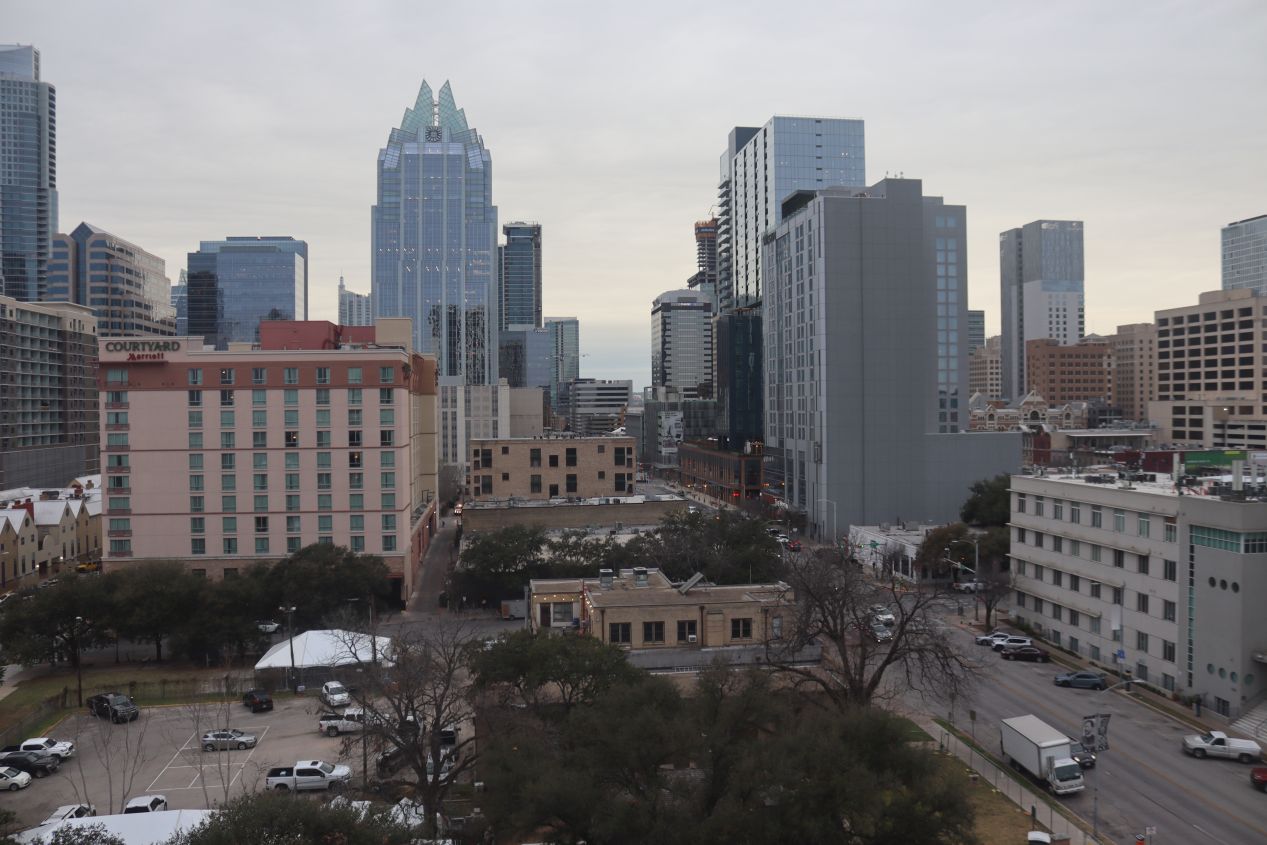


These are some pictures taken from the rooftop pool area of the Hilton looking out at the Austin skyline as well as the Austin Convention Center itself. The weather was surprisingly cold for March in Austin; we had been checking the temperatures and most of the time the daily highs were around 60-70 degrees Fahrenheit (about 20 degrees Celsius). Not so much on this trip as the thermometer struggled to crack 40 Fahrenheit / 5 Celsius and I was wearing two layers of coats for my walk around town. I was following my usual pattern of getting an early start to the day and took these pictures around 7:30 AM while there wasn't much activity taking place yet.

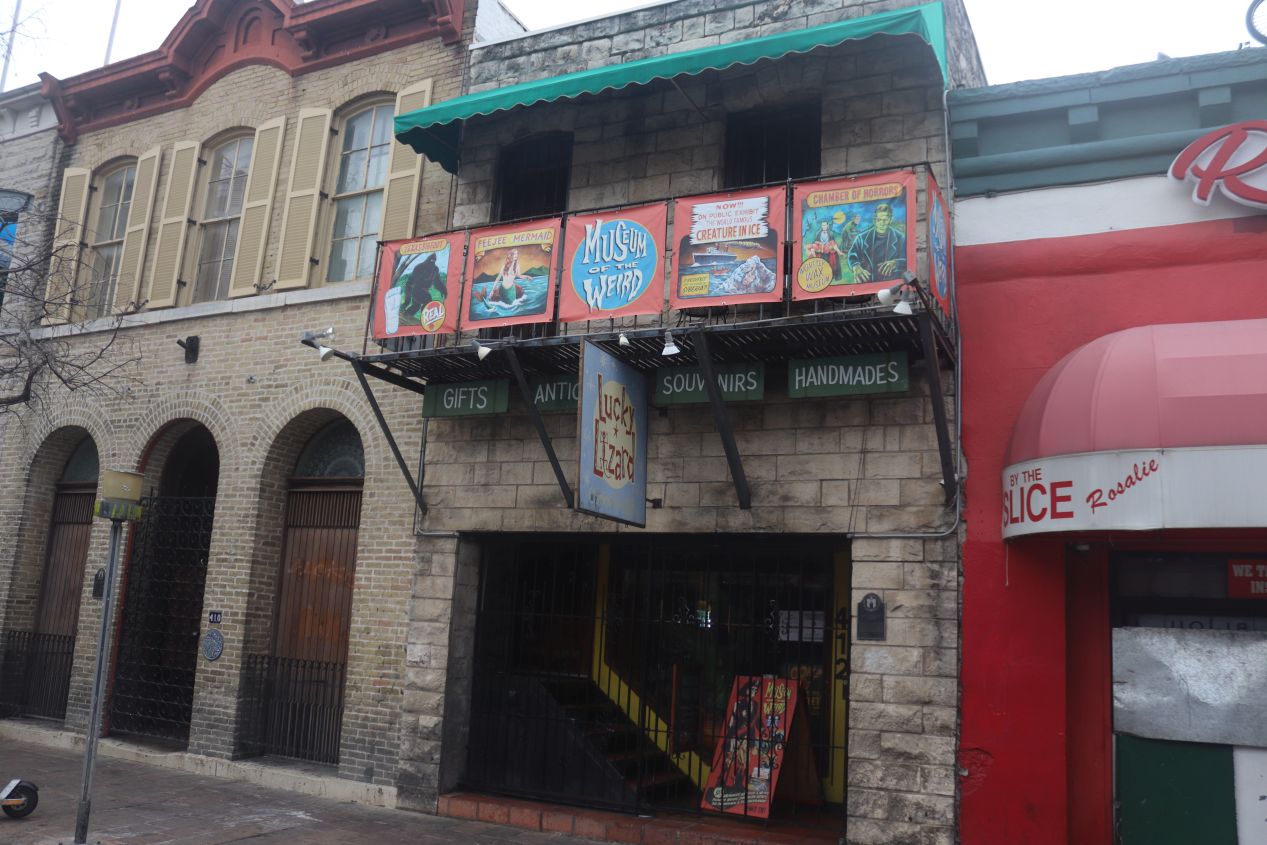


Our hotel was located on Fifth Street and it was therefore a walk of only one block to reach Sixth Street, the historic heart of the entertainment district in Austin. Formerly named Pecan Street, this thoroughfare hosts a series of bars, clubs, music venues, and restaurants along its length. It was quiet and largely empty on a Tuesday morning in early spring but I could easily see that this area would be packed with visitors on a warm summer night. Some notable sights along Sixth Street included the Museum of the Weird which was a tourist trap dedicated to oddball attractions similar to the old timey carnivals. There's an unofficial city slogan called "Keep Austin Weird" which this museum was leaning into. Sixth Street also had a branch of the Voodoo Doughnut chain which is infamous for selling bizarre types of doughnuts to customers. I didn't stop in the store this morning but we did get some breakfast there the next day; I ordered some basic cinnamon spice doughnuts while snapping this picture of some of the more outlandish ones on sale. I'm not sure that doughnuts + bacon is a combination that goes together!

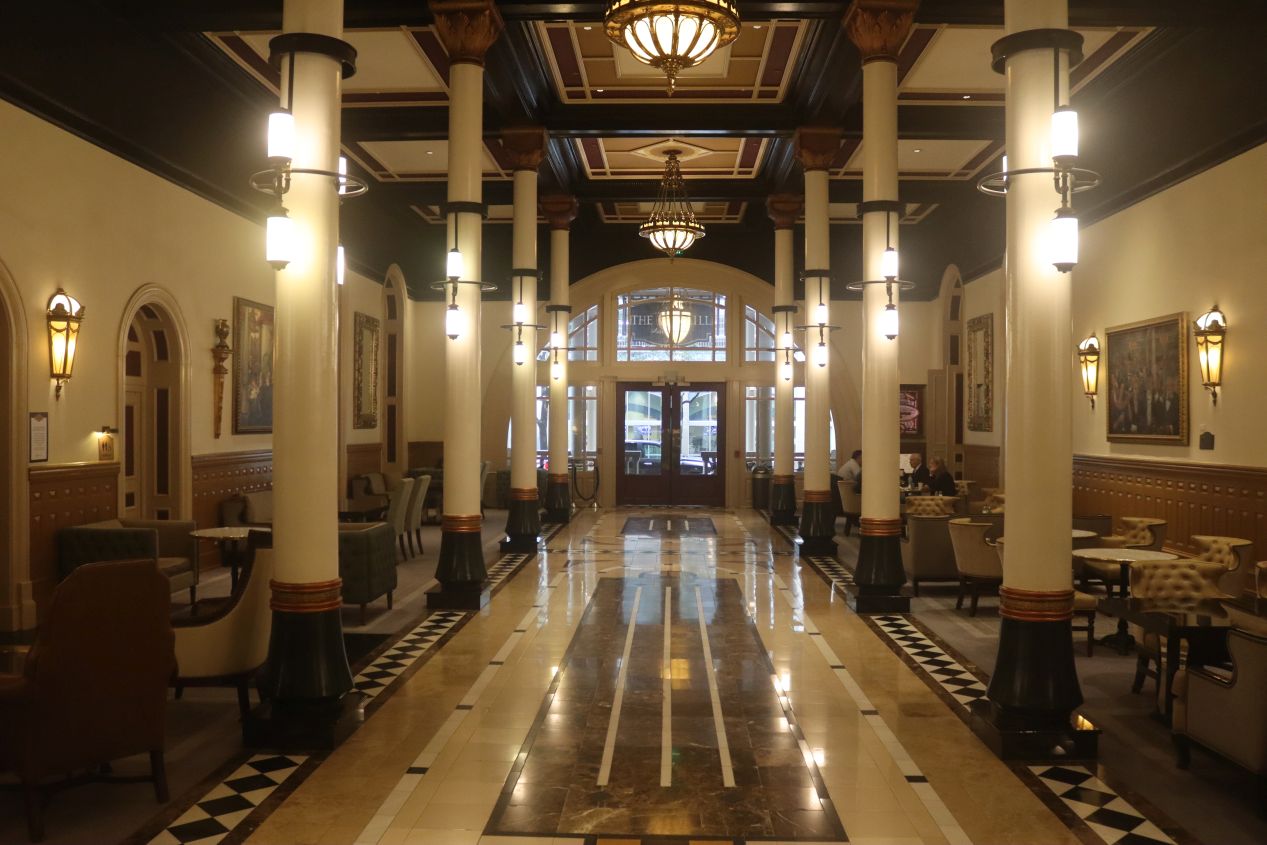


A few blocks further up Sixth Street I found this building, the historic Driskill Hotel. Named after founding cattle baron Jesse Driskill, the hotel dates back to 1886 and remains one of the most famous and luxurious hotels in the state of Texas. This was the spot where future president Lyndon Johnson met his wife Lady Bird for the first time and the location where the two of them ran his congressional campaigns in the 1940s and 1950s. The Driskill is also infamous for supposedly being one of the most haunted hotels in the USA, with various stories alleging that Jesse Driskill's ghost has been repeatedly seen here along with two "suicide brides" who killed themselves in the hotel's rooms. Leaving aside the paranormal reputation of this place, the Driskill certainly had a beautiful old-timey entrance hall full of elegant columns and colorful glass on the ceiling. I checked the price for a night's stay when writing this article and the out-of-season March rate in 2022 wasn't too ridiculous starting around $200 for a room. This is a place that's somewhat affordable for its historic nature.

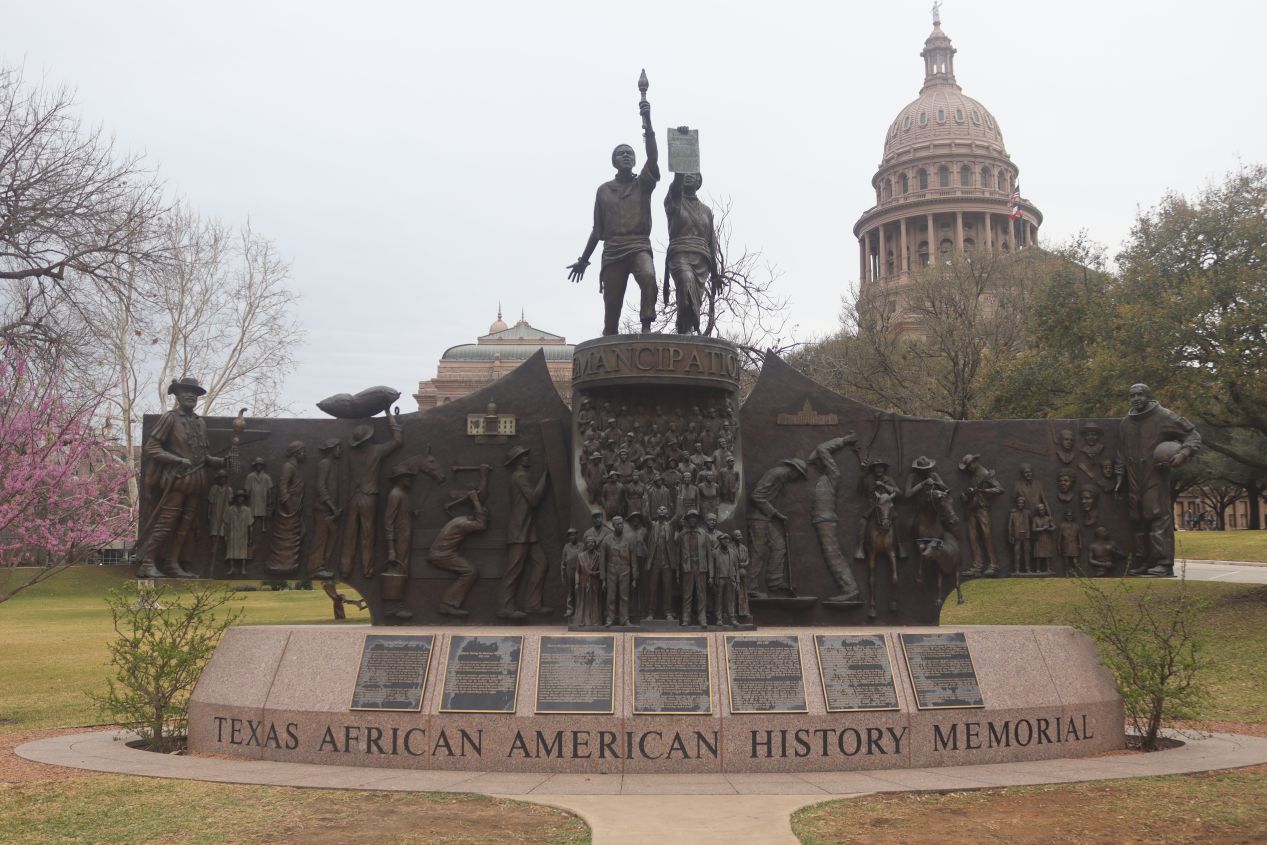


My first major stop for the day was located a few blocks north of Sixth Street at the Texas State Capitol building. This building dates back to the 1880s and matches the size of Texas by being one of the largest state capital buildings. The central dome rises just over 300 feet / 90 meters in height and exceeds the national Capitol building in Washington DC in size. I was approaching the Texas State Capitol from the southern entrance where the walkway passed by the four oldest monuments on the grounds. These included statues commemorating the Heroes of the Alamo, the Texas Rangers (not the baseball team), volunteer firefighters... and the soldiers of the Confederacy. Texas is known for its conservative politics and the state is sending a clear message of support by keeping this monument in such a prominent place on the capital grounds. Then again, this is the state that still celebrates "Confederate Heroes Day" each year on January 19th (Robert E. Lee's birthday) despite innumerable attempts to get rid of the holiday. I'm glad that there have been recent monuments added to commemorate African American and Tejano history on the state capital grounds (in less visible locations off to the side) but this doesn't solve the problem. I don't see monuments celebrating the Nazi regime when I travel to Germany, and the presences of statues glorifying a rebellion dedicated to preserving slavery says nothing good about the people who put them up.

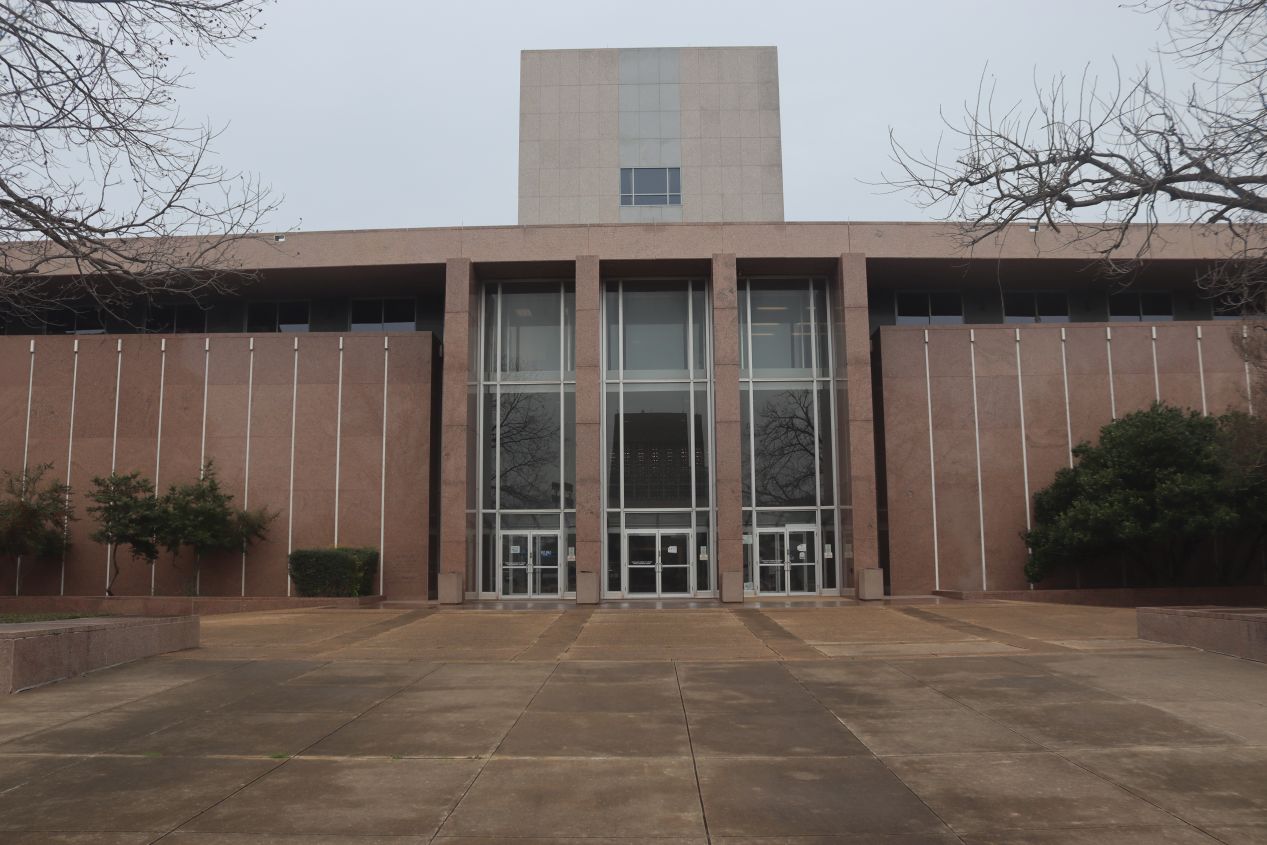


These pictures were taken after circling around to the northern side of the Texas State Capitol building. The blocky, unattractive structure in the second picture was the Supreme Court of Texas which can be found next to the Capitol building on the same grounds. The north side of the Capitol contains a huge underground extention which was added in the 1980s to provide much-needed additional office space. This extension is completely invisible from the outdoors except for the pictured four story open-air inverted rotunda. Standing next to the rotunda and looking down into it was a bit like gazing into a large well with a big star and the "Texas" letters down at the bottom. It was raining pretty hard when I was taking these pictures so I didn't waste too much time in this part of the exterior grounds.

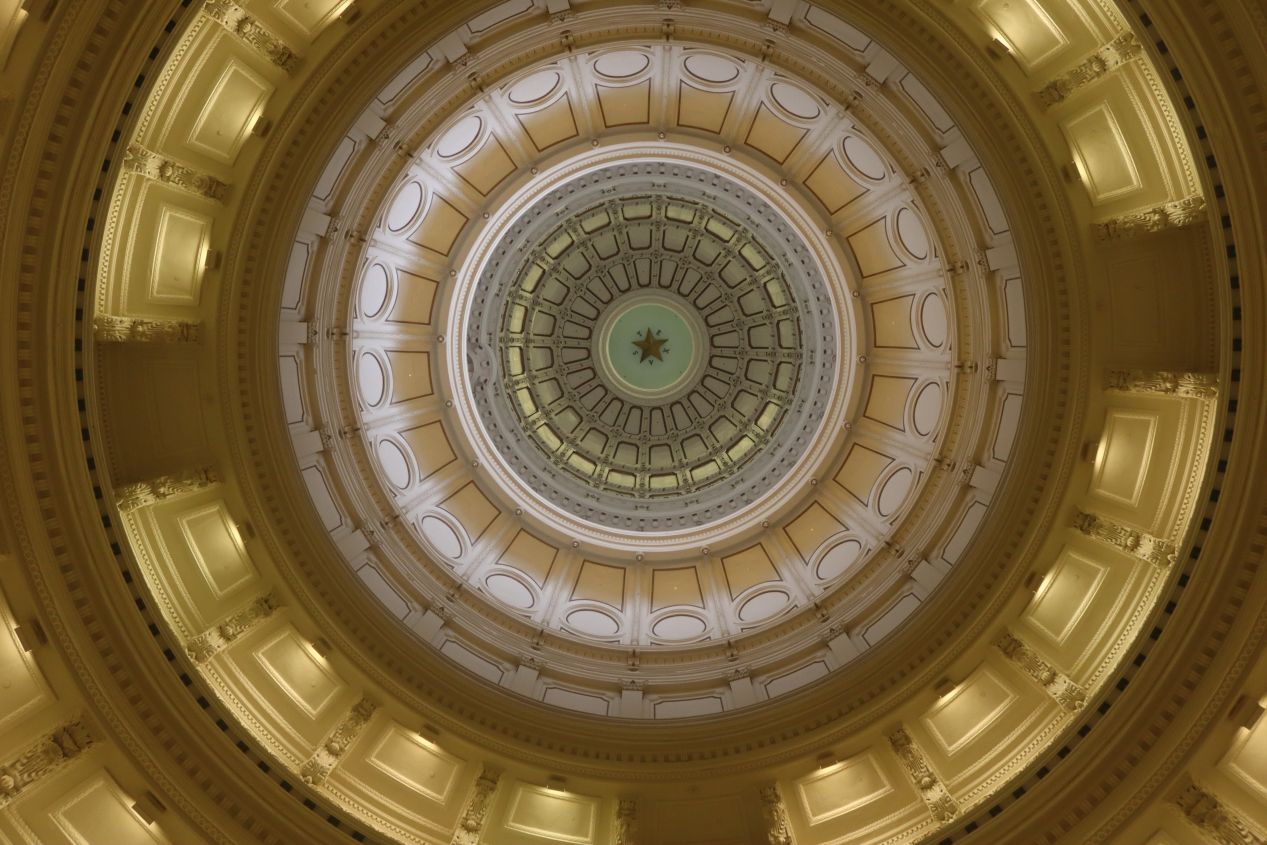


The Texas State Capitol is unusual for opening to the public at the very early time of 7:00 AM each morning. I arrived a little after 8:00 and unsurprisingly found that the place was largely devoid of other tourists or pretty much anyone else at all. The hallway led from the entrance directly to the open central dome where the ceiling rose far up overhead, above a floor design commemorating the six different governments that have held sovereignty over Texas. (This is where the Six Flags theme park chain gets its name from; the six nations were colonial France, colonial Spain, Mexico, the Texas Republic, the United States, and the Confederacy.) I found that the Texas State Capitol followed the same pattern as most other state capitol buildings by having the first floor given over to various offices. The second floor of the building then held the governor's office with the two legislative chambers each having their own wings of the structure.

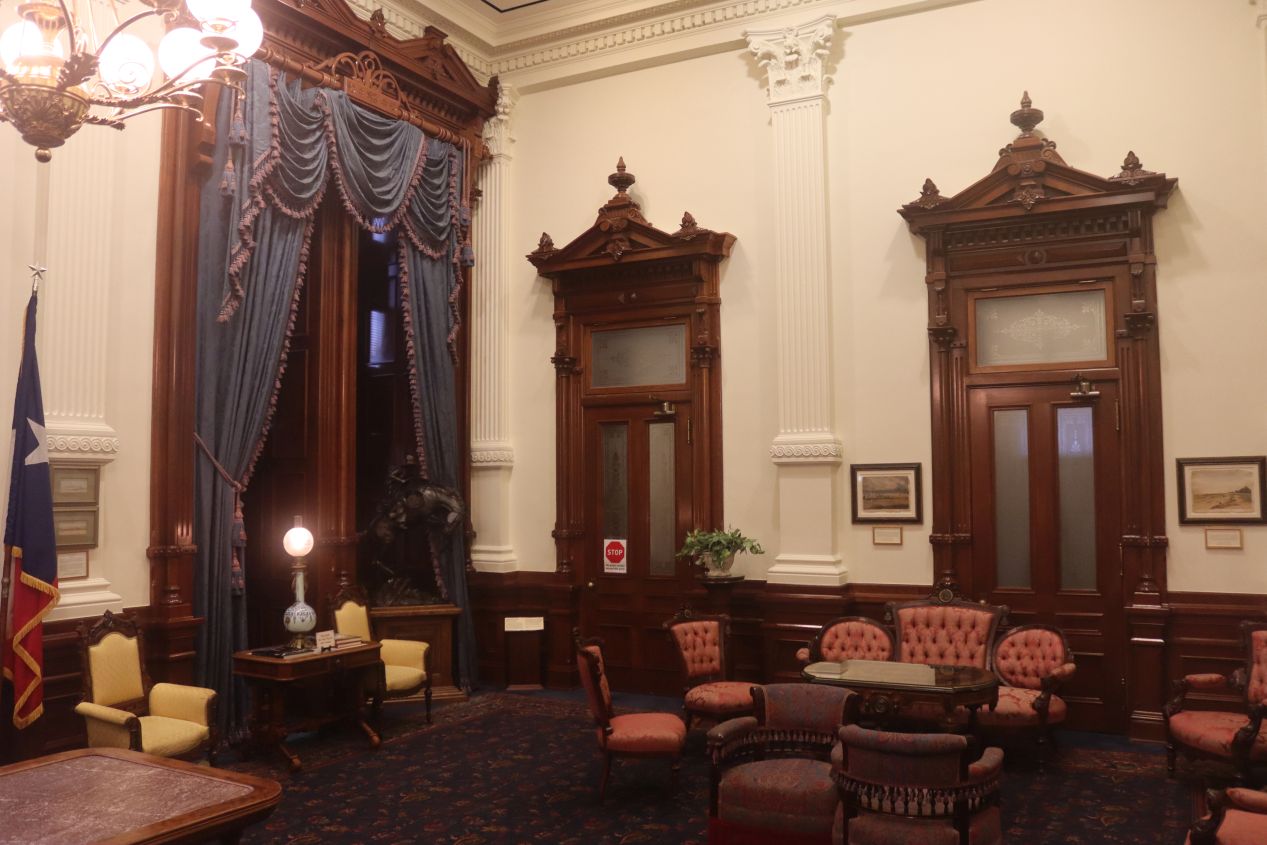


Speaking of which, these first two pictures were taken from the Governor's Public Reception Room on the second floor. Texas is unusual for being a state where the governor shares a great deal of power with the lieutenant governor, who is elected separately and presides over the Texas Senate in a non-ceremonial way. The governor in Texas is therefore notably weaker than in most other states where the lieutenant governor position is a mere formality similar to the vice presidency. Greg Abbott was the governor at the time of this visit in 2022 but of course he wasn't hanging around in this reception room early in the morning on a Tuesday. The only person present was this Texas Ranger behind the desk who was quite friendly and happy to let me take a few pictures of the area. It looked like a beautiful room from the small portion open to the public.
The other two pictures were taken from the legislative library on the northern side of the state capitol. The library wasn't directly open to the public but there was a skylight of sorts up on the third floor where I could look down into the archival records. This wasn't a particularly large library and it was obvious that for a state as big as Texas there had to be a separate library somewhere else to store all of the official records. Sure enough, the Texas State Library and Archives was located a short distance away elsewhere on the capitol ground which I would be visiting a little bit later. This room was solely designed to house the legislative records.

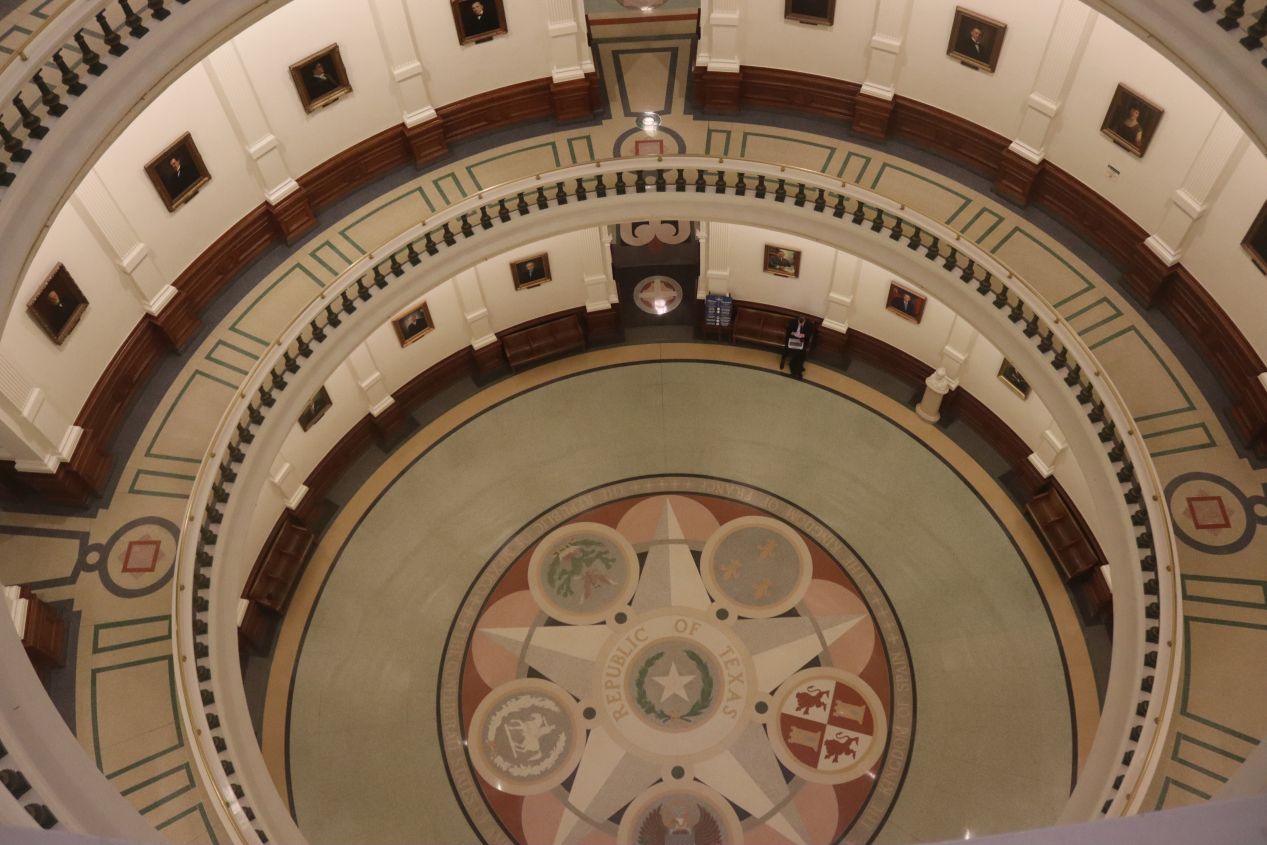


As I climbed higher up into the upper floors of the Texas State Capitol building, I was able to snap these pictures looking up at the top of the dome and down at the lone star emblem built into the floor. The doors to the two legislative chambers were shut when I arrived and it looked at first as though I wouldn't be able to enter inside. I used my phone to search the Texas State Capitol website to see if there was an opening time posted and I couldn't find any information at all. However, it was 8:55 AM and I decided I would wait a few minutes to see if they would open for the day at 9:00. Sure enough, a few minutes later a staffer arrived and unlocked the doors, allowing me to enter the pictured Texas State House chamber. I was struck right away by the huge size of this room, much larger in comparison to many of the other state capitol buildings that I've visited. The Texas State House has 150 members who are each elected to two year terms. It was split 85-65 in favor of Republicans at the time of my visit, both due to the conservative-leaning nature of Texas and some truly egregious gerrymandering that Texas Republicans have carried out to maintain a lock on control of the legislature.


The other side of the building held the corresponding upper house of the Texas legislature, the Texas Senate. This was another room that was physically large, with a viewing gallery running all the way around the chamber instead of being limited to one area, but with only 31 senators for the whole state. Texas state senators are elected to four year terms of office and this is the chamber where the lieutenant governor essentially runs the show since there are no majority or minority leaders. Texas has been dominated by one-party political rule for the entirety of its history, with the Democratic party controlling the Texas Senate continuously from the end of Reconstruction up until 1997 followed by uninterrupted Republican control since then. There was no big flip where the state suddenly became more liberal or more conservative; the state has always been run by political conservatives, the parties they were attached to simply changed names over time. Texas has historically been controlled by ranching and oil/gas interests which have only recently been challenged by the incoming technology and financial industries; where this ends up in time is anyone's guess.

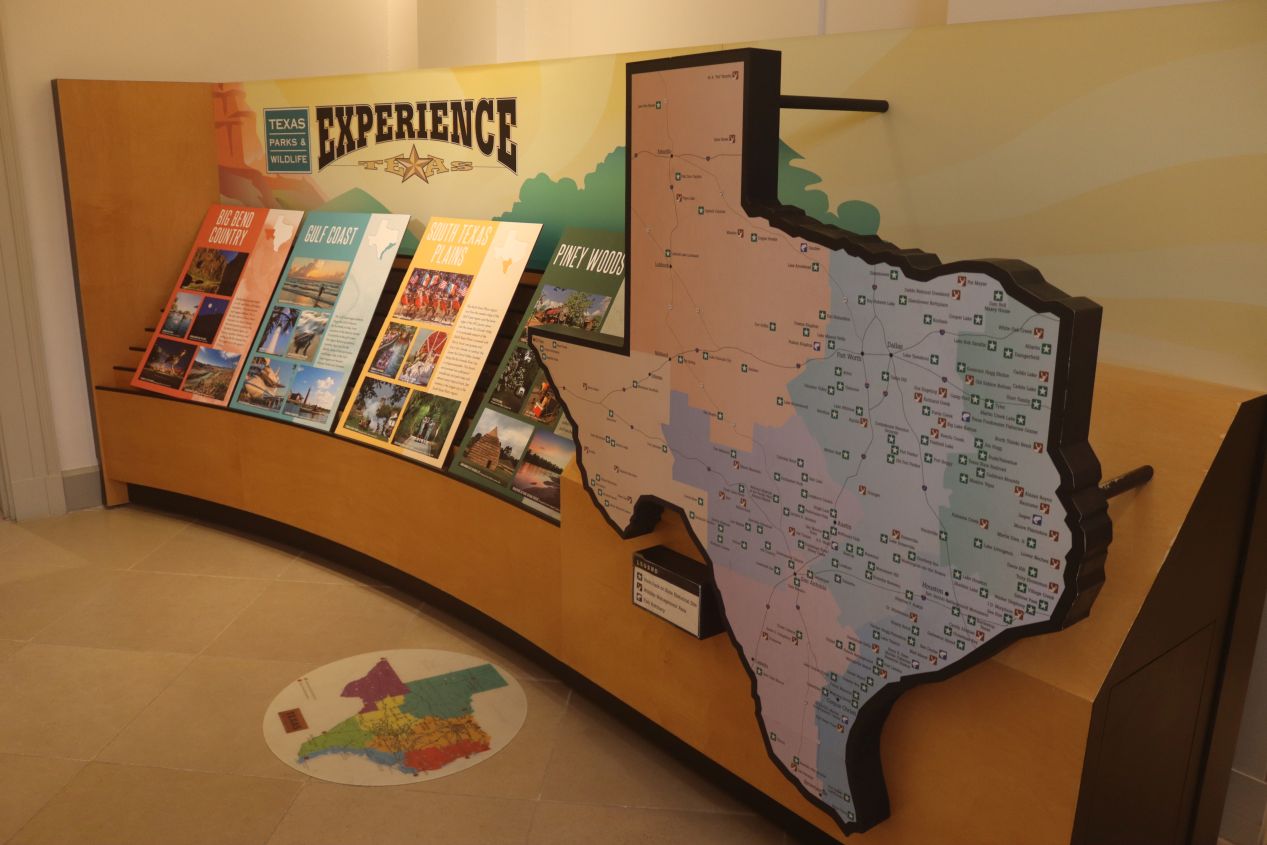


After finishing up with the Texas State Capitol building itself, it was a short walk to the Texas Capitol Visitor Center located nearby on the same grounds. It might have been more logical to start at the visitor center first however the latter building didn't open until 9:00 AM, after the state capitol itself had already opened to the public. The Capitol Visitor Center had three stories full of small exhibits about various aspects of the state of Texas. There was some background about the various geographical parts of the state, a section on the Texas Governor's Mansion which is normally closed to the public, additional information about the construction of the State Capitol building, an open area clearly used by school groups for activities, and so on. I think that I was most amused here by the "Don't mess with Texas" trash can, an odd place to put a vaguely-threatening slogan about the state's toughness.

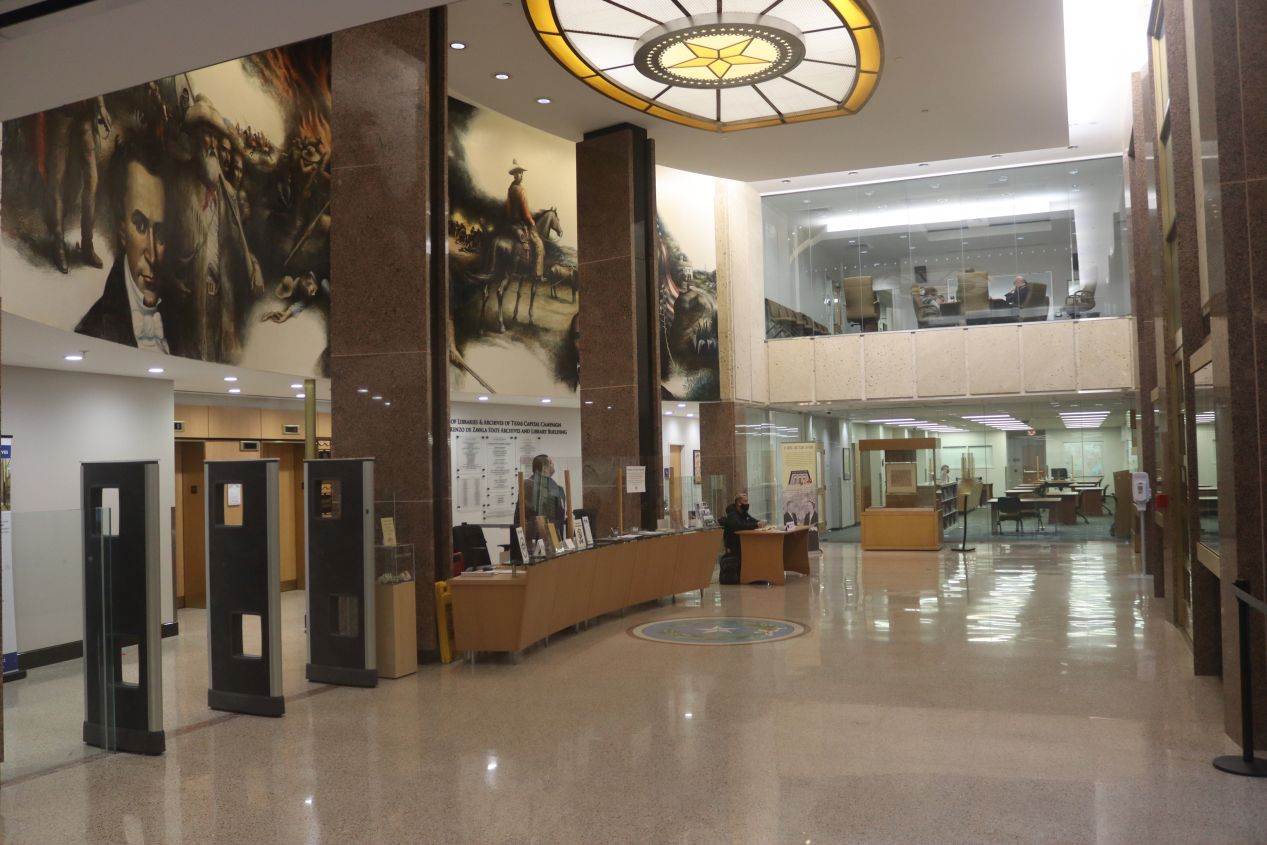


Also located on the state capitol grounds was this building housing the Texas State Archives and Library. This is mostly a research facility used by scholars or journalists who have to dig into the state records for one reason or another. There was a small exhibit space in the lobby of the building housing some of the featured items from the collection, such as an original copy of the Constitution of the State of Texas and several letters written by the defenders of the Alamo when they were under siege. The pictured Declaration of Independence for the Republic of Texas was in pretty sad shape, not surprising given that the document was almost 200 years old and hadn't been written on something designed to be preserved for the long haul like parchment or vellum. It looked like someone had accidentally spilled some ink in the signature section which was an amusing detail to be captured in history.

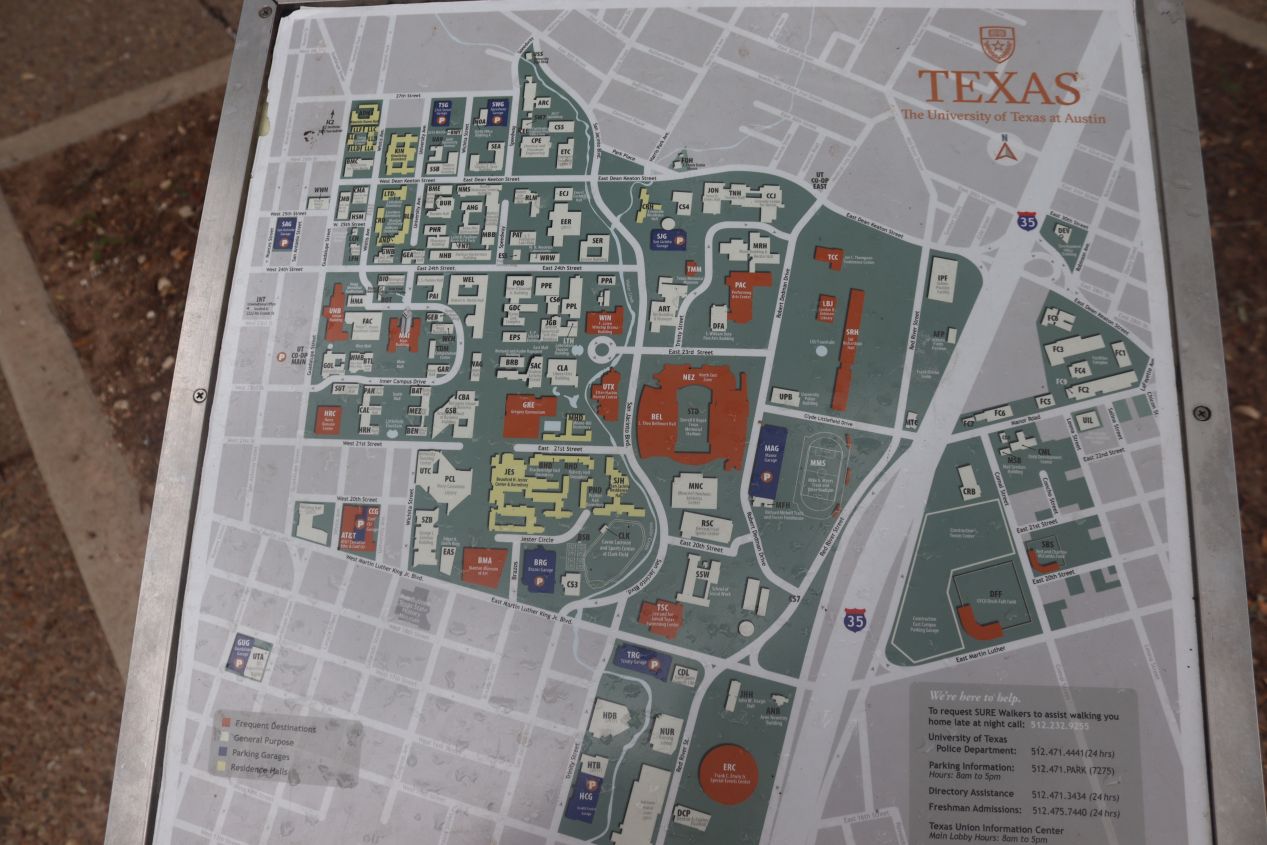


The state archives was the last building that I visited on the state capitol grounds. I continued heading further north and after a couple of blocks passed by the Bullock Texas State History Museum. It was closed for the day as I had known it would be; the museum wasn't open on Mondays or Tuesdays which were the only two days that I had to spend in Texas. Otherwise I would have certainly visited the museum and spent an hour or so inside. Walking another block to the north brought me onto the campus of the University of Texas at Austin, the flagship university of the Texas collegiate system and one of the largest universities in the United States. The University of Texas had more than 50,000 enrolled students at the time of writing in 2022 which is a huge number even for a big state school. This is one of the best public universities in the nation, usually ranking somewhere around 10-15th place amongst public universities in those big lists, and I applied and was accepted into the history graduate program at the University of Texas back in 2004. (I ended up staying at the University of Maryland for my history Ph.D program.) These were a few pictures that I took while walking along the southern end of the UT campus, outside the business school and the alumni center.

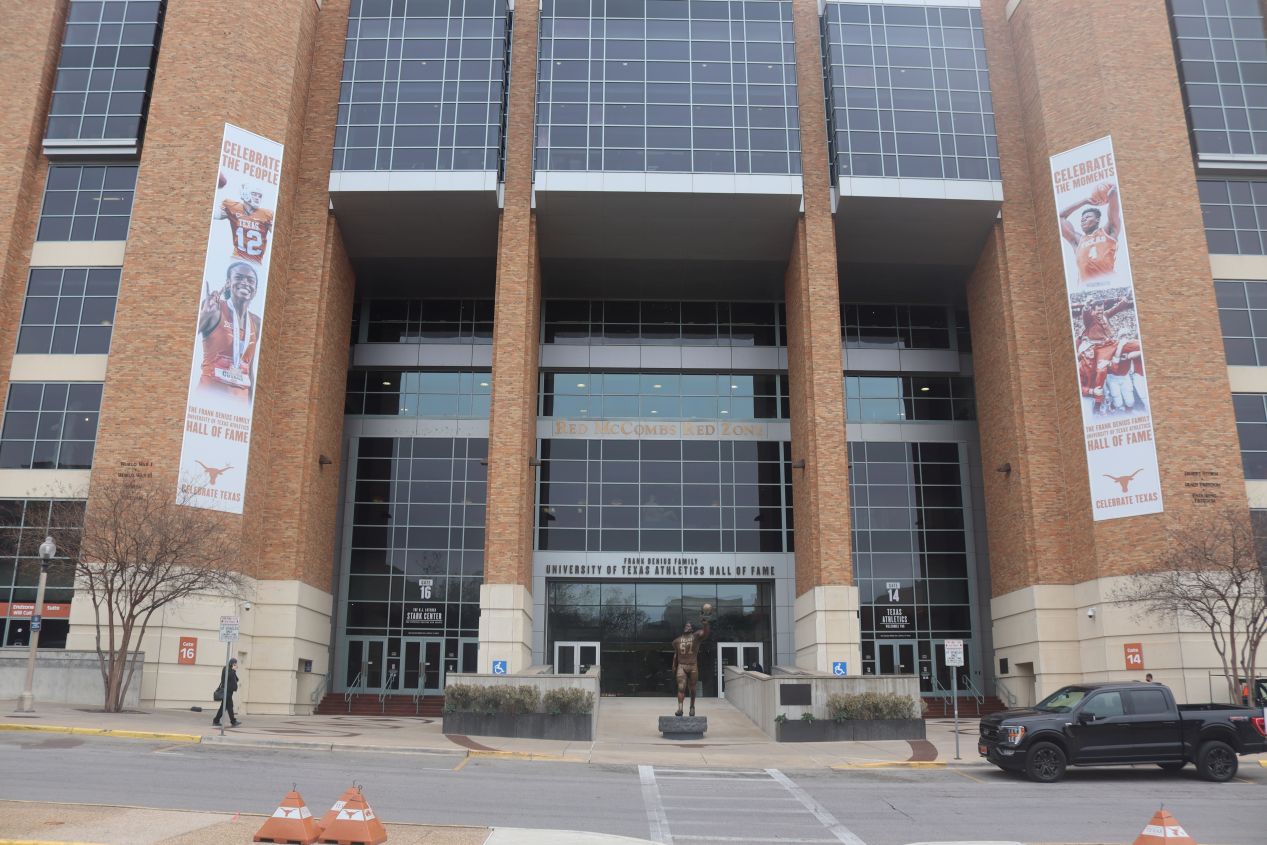


I was heading for the dominant feature on the eastern side of the UT campus: Darrell K Royal Texas Memorial Stadium. This humongous stadium has been home to the football team since 1924 and has been repeatedly expanded over the decades to the point where it now holds just over 100,000 spectators. At the time of writing, it was the largest stadium in the Big 12 Conference (for the limited time remaining before Texas moved to the SEC) and roughly the 10th largest stadium in the world. I started on the western side of the stadium and walked a slow counterclockwise loop around the hulking exterior on "Bevo Boulevard". That's the name of the live mascot of the Texas Longhorns, a real steer with burnt orange and white coloring from which the university derived its color scheme. There's been a long succession of these animals over the years and Texas was on Bevo XV when I visited. These animals weigh close to 2000 pounds / 900 kilograms so their handlers have to know what they're doing to keep them under control.
As I was walking around the south side of the stadium, I spotted that there was a gate left open for construction purposes. No one was around watching the entrance so I decided to press my luck and ducked inside to take a look around. That's how I was able to walk right onto the field itself and take these pictures:

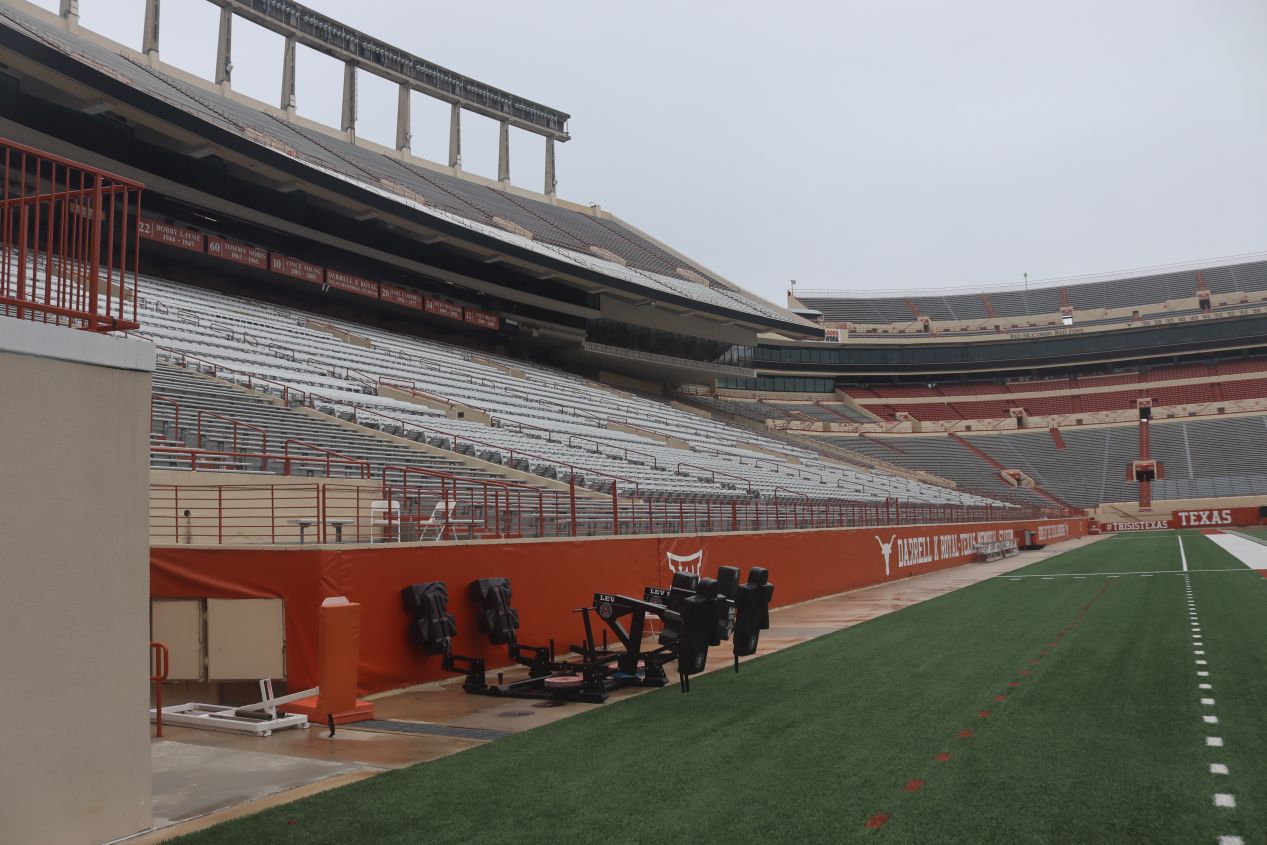


Not bad, right?  I had been down on a lot of football fields thanks to my time with the University of Maryland marching band and this was as large of a stadium as I could recall visiting, right up there with the Orange Bowl in Miami and the old Georgia Dome in Atlanta before it was torn down. A long expanse of field turf stretched out in front of me with Bevo's corral close by off to my right. It goes without saying that University of Texas football is overwhelmingly the most popular sport in Austin and little short of a religion for many fans. Texas has been very successful over its history with four national championships and an amazing 32 conference championships, especially in the old Southwest Conference which Texas won 27 times before it disbanded in the 1990s. Texas won its most recent national championship in 2005 when Vince Young led them to victory in one of the most thrilling title games I can remember watching. Texas football had been going through a recent rough patch at time of writing in 2022 and things certainly won't be getting any easier when the university moves to the SEC in 2025. This is one of the all-time most winning college football programs so they'll probably figure things out sooner or later.
I had been down on a lot of football fields thanks to my time with the University of Maryland marching band and this was as large of a stadium as I could recall visiting, right up there with the Orange Bowl in Miami and the old Georgia Dome in Atlanta before it was torn down. A long expanse of field turf stretched out in front of me with Bevo's corral close by off to my right. It goes without saying that University of Texas football is overwhelmingly the most popular sport in Austin and little short of a religion for many fans. Texas has been very successful over its history with four national championships and an amazing 32 conference championships, especially in the old Southwest Conference which Texas won 27 times before it disbanded in the 1990s. Texas won its most recent national championship in 2005 when Vince Young led them to victory in one of the most thrilling title games I can remember watching. Texas football had been going through a recent rough patch at time of writing in 2022 and things certainly won't be getting any easier when the university moves to the SEC in 2025. This is one of the all-time most winning college football programs so they'll probably figure things out sooner or later.

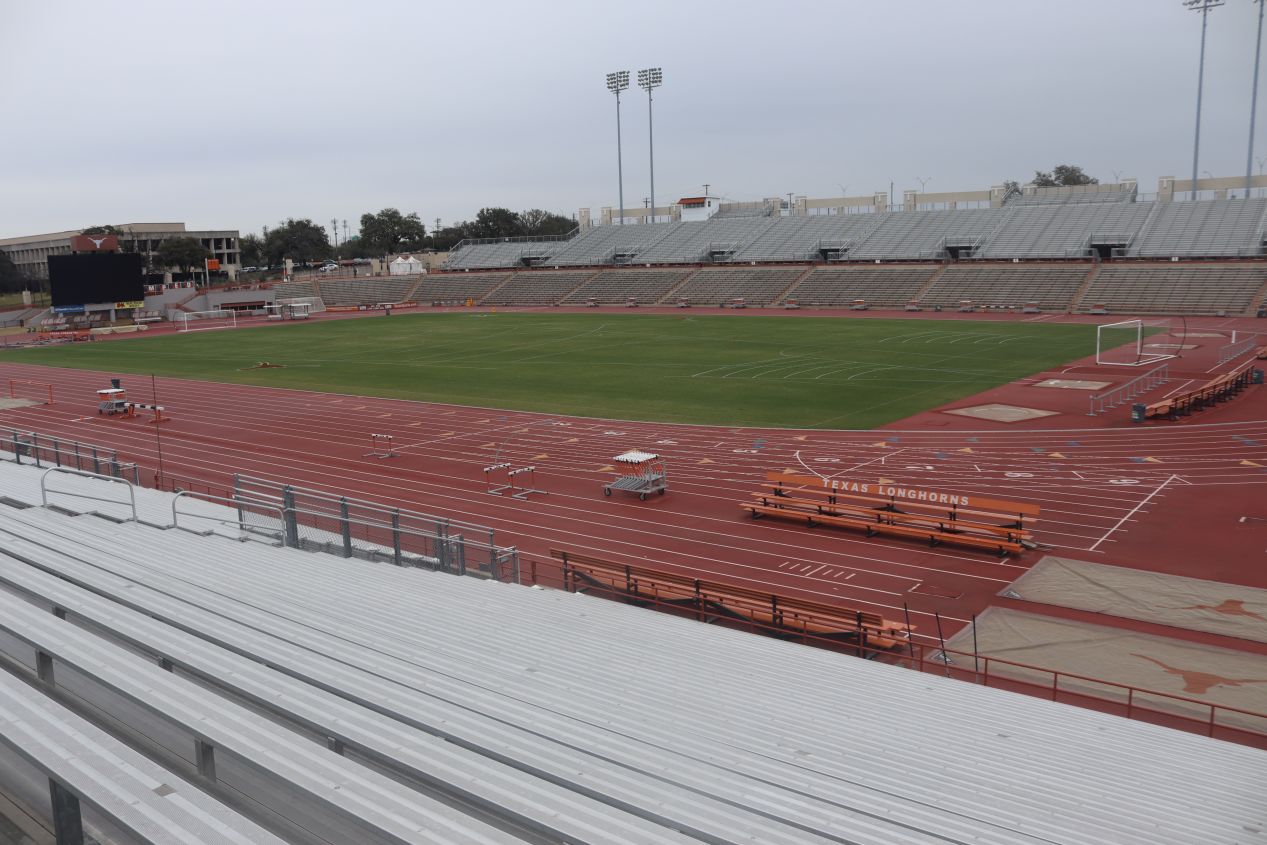


These were some pictures that I took as I walked around the eastern side of Texas Memorial Stadium. The road over here was completely torn up by construction work and there was heavy rebuilding of some kind taking place at the Moody Center, the indoor arena on campus. I actually had to climb up to the top floor of the parking garage to keep heading north around the edge of the stadium. That wasn't all bad though because I was able to use the added elevation to look back at downtown Austin to the south as well as peek into the track and field stadium next door. This is officially named the Mike Meyers Stadium which sounds like some kind of Halloween joke but is the real name of the place. The Performing Arts Center was also situated out here towards the edge of the campus and advertising a student production of the Lion King musical.

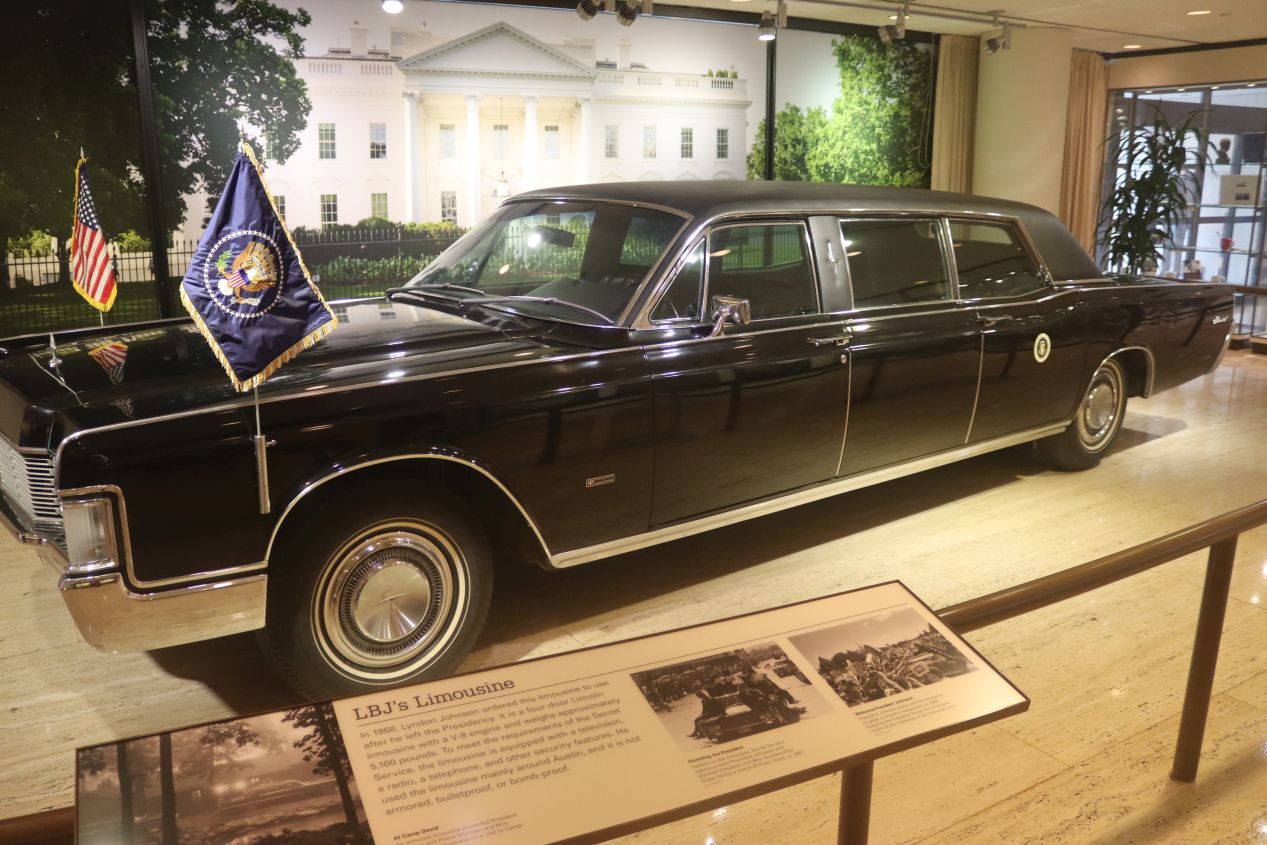


I had walked to the outskirts of the UT campus in order to visit this building, the Lyndon Baines Johnson Presidential Library and Museum. This was the first presidential library to be located on a university campus when it opened in 1971, a trend which has become popular in the decades since. LBJ chose the design for this unadorned 10 story square building to house the presidential records from his administration; it definitely felt like a structure that was built during the 1960s. Visitors enter on the third floor which houses the presidential limousine and a gift store full of various campaign memorabilia. The rest of this entry floor was mostly given over to an excellent exhibit about the life of LBJ's wife Lady Bird Johnson (originally born Claudia Taylor) who was a remarkable individual in her own right. Lady Bird Johnson is most famous for her environmental work but she was also a savvy businesswoman and a skilled political campaigner. The Johnsons evidently had a whirlwind romance as the two of them were married only weeks after they first met in 1934; LBJ apparently asked her to marry him on their very first date! He must have had immense confidence in himself to make a request like that and actually have it work out. (It shouldn't be a surprise that LBJ also had numerous affairs with other women, something that his presidential library definitely did not discuss.)

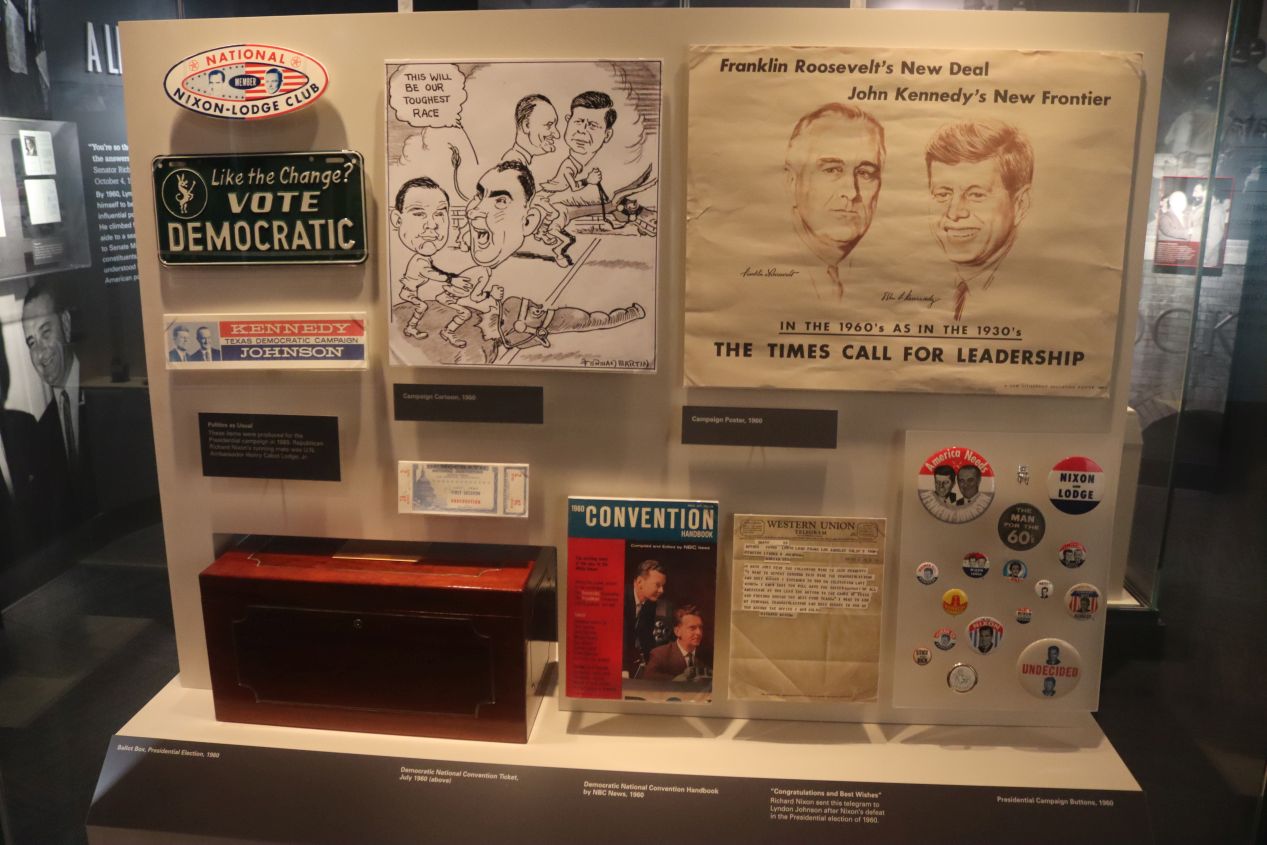


The main exhibit at the LBJ Presidential Library was located up a small flight of stairs on the fourth floor, where the building opened up into a huge open space that stretched up to the ceiling far overhead. The third and fourth floors were devoted to museum space while floors five through nine contained the archival material available for researchers, with the stacks of red-colored volumes visible from this central open spot. The main exhibit was of course devoted to the events of LBJ's presidency, starting with the 1960 campaign in which he was John F. Kennedy's vice presidential candidate and then moving quickly through the Kennedy assassination and into LBJ's own presidency. My favorite artifacts on display were various hand-written notes from Johnson, such as the pictured edits to the brief remarks that he gave to the public following Kennedy's assassination in 1963. There were other such notes where he made last-second changes before giving speeches to Congress or international meetings with the Soviet premier (Brezhnev at the time).

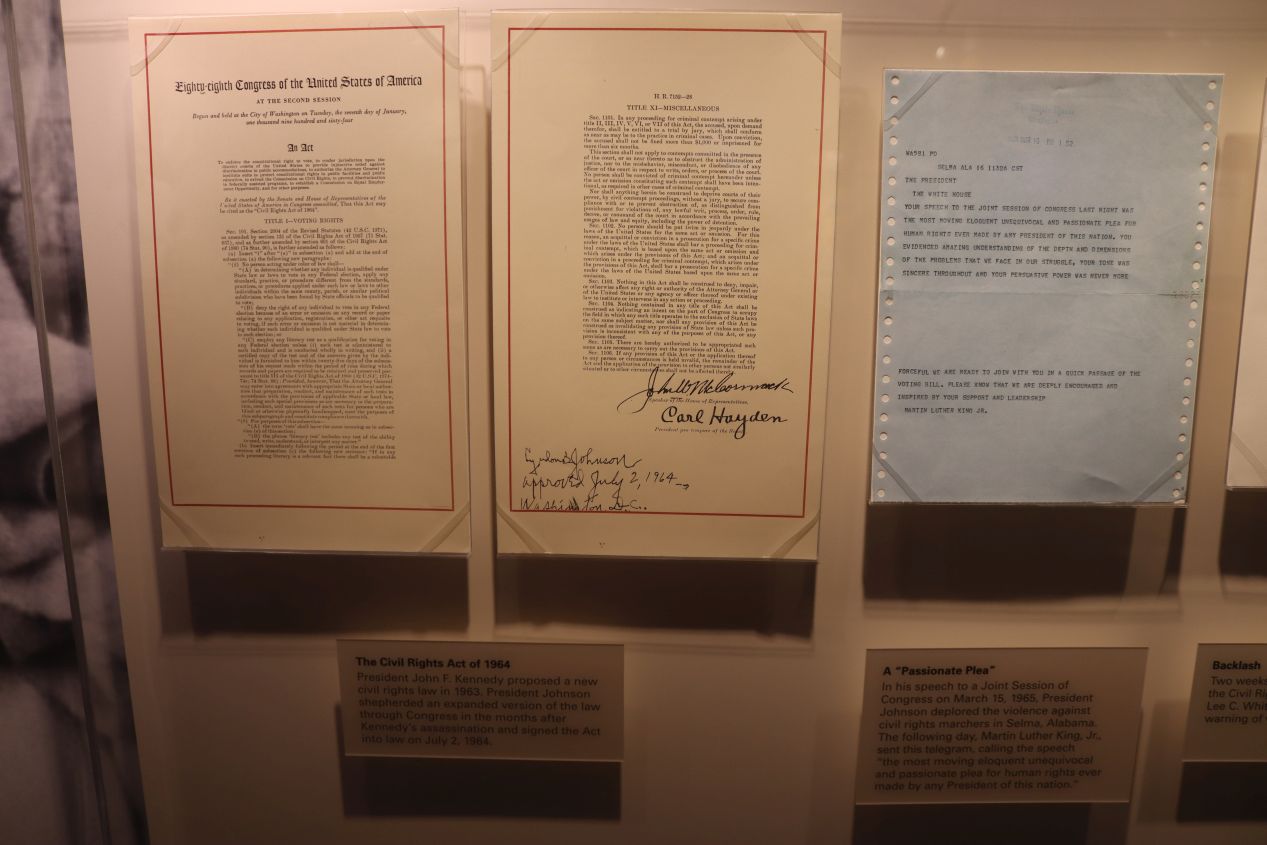


The museum walked visitors through the staggering array of social programs created by the Johnson administration as part of his Great Society initiative. LBJ was responsible for the Civil Rights Act, the Voting Rights Act, the creation of Medicare and Medicaid, immigration reform that opened the United States to non-Europeans for the first time since the 1920s, the Freedom of Information Act, the National Endowment for the Arts, the creation of the Departments of Transportation and Housing and Urban Development (HUD), and the first wave of environmental legislation. It was the the most sweeping series of reforms since the New Deal a generation earlier and LBJ's domestic policies continue to have a major effect on the present day. I should know since I work for Medicare which was created in 1965 as part of this wave of legislation. However, LBJ was also responsible for repeatedly escalating the war in Vietnam and this was the issue that ultimately brought down his presidency. Johnson felt that the United States had to take a strong stand against the spread of communism overseas, not least because Democratic presidents were always attacked for being soft on communism during the Cold War, and this led the country into a disastrous overseas quagmire that killed more than 50,000 Americans (and over a million Vietnamese) with virtually nothing to show for it. It's impossible to discuss the positive achievements of the Johnson administration without also noting the utter failure of his foreign policy in Vietnam.

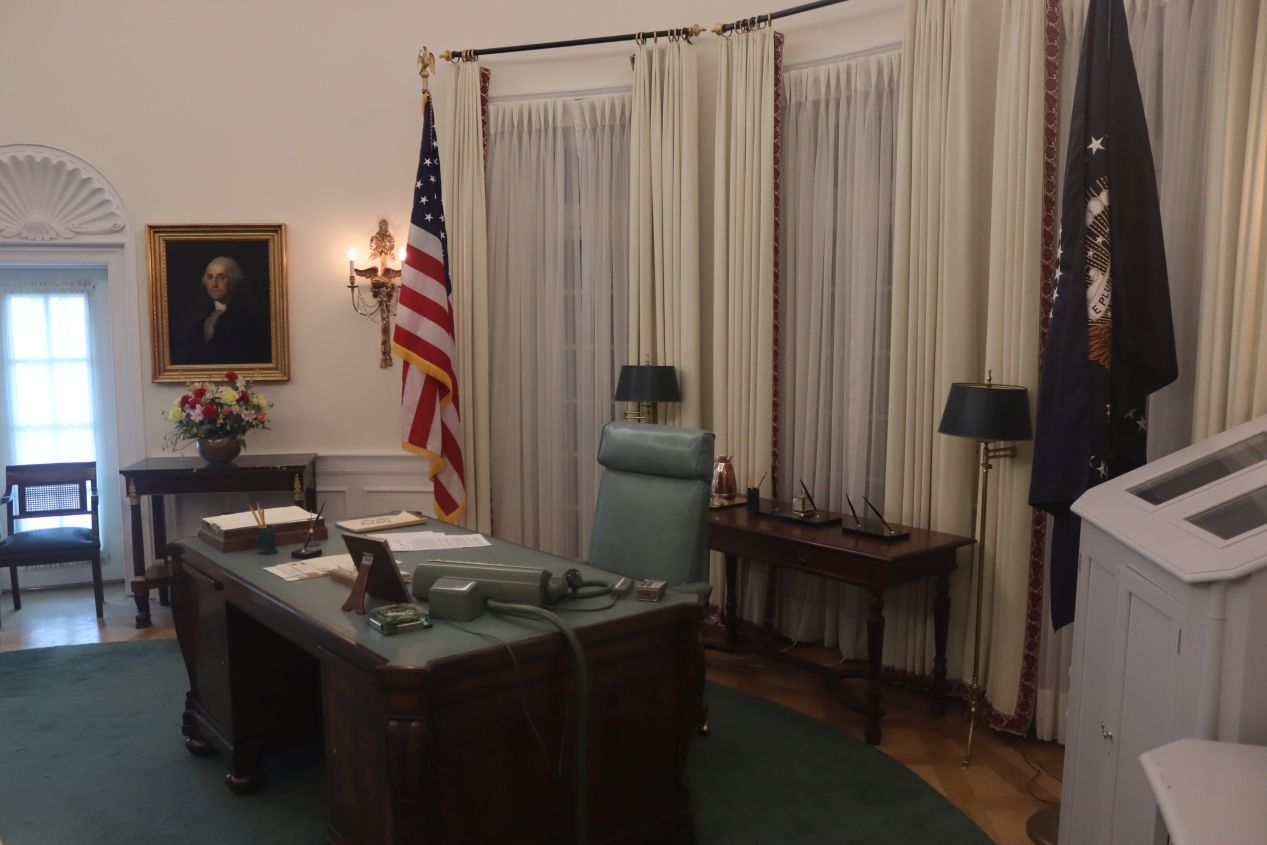


There was one final addition to the museum, a small exhibit space up on the tenth floor of the building located above the archives. The highlight here was a replica of the Oval Office of the White House as it looked during LBJ's administration, created at 7/8th scale of actual size. Visitors could look at this model replica but not go inside. There were several other small exhibits on this floor ranging from some of the gifts given by other countries to the first family along with a reproduction of Lady Bird Johnson's own office from the same period. I appreciated how much of the museum space was given over to Lady Bird Johnson and this place would be more accurately named to reflect both members of the presidential family. This was a great place to spend an hour poking around and I definitely recommend it to anyone else who has an interest in history.

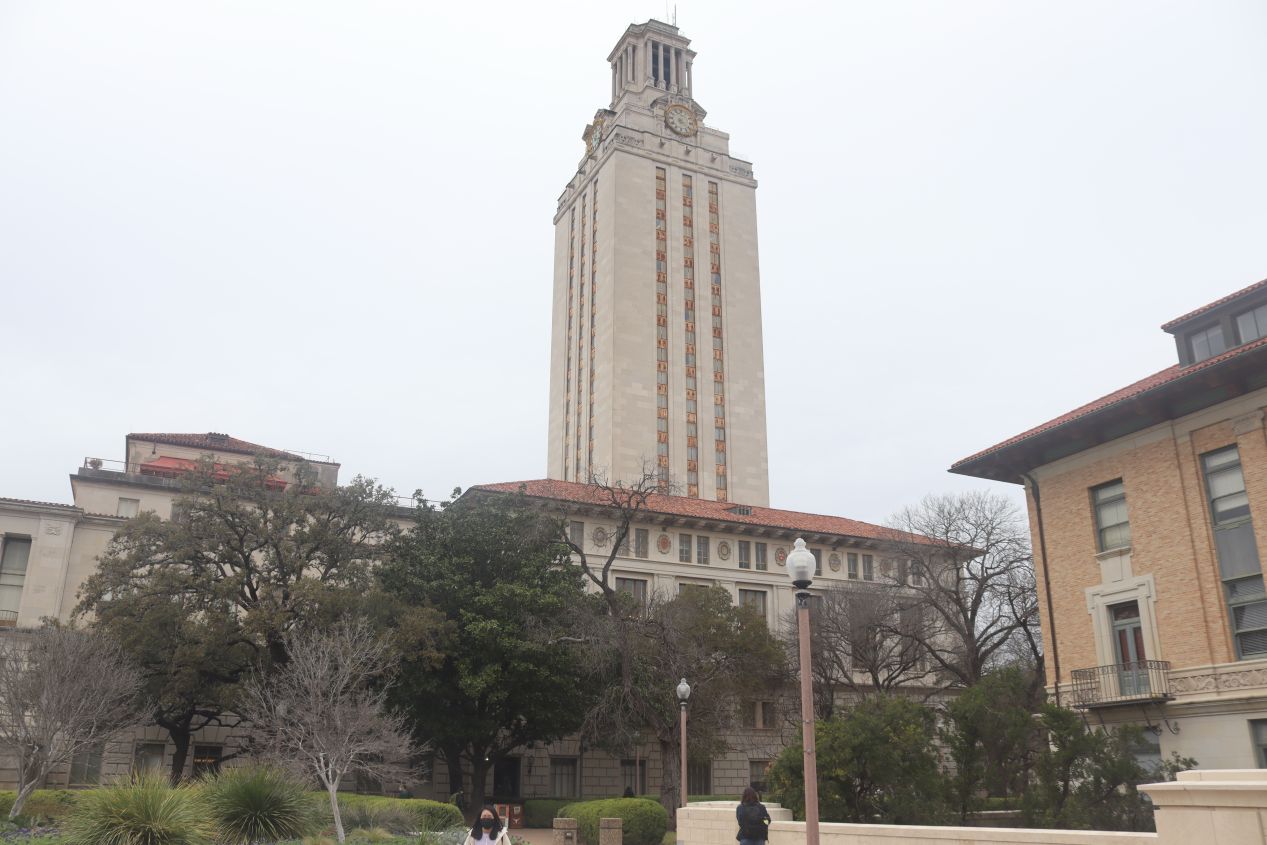


I was still on the campus of the University of Texas and started walking back towards its center. I was heading towards the easily-visible tower of the Main Building housing the administration of the university. This building dates back to 1937 and features the 307 foot / 94 meter tall tower that serves as one of the most recognizable symbols of the University of Texas. Unfortunately the tower is also infamous for being the location of one of the worst mass shootings in American history when a Texas student barricaded himself atop the tower in 1966 and went on a killing spree, ultimately killing 15 people and injuring 31 more before police were able to kill the shooter. This was the first mass shooting at a school and it shocked the nation; sadly school shootings have become all too common in the United States as conservatives inevitably block any attempt to address gun violence. The observation deck of the tower is normally open for visitors but I found that it was closed for COVID-related reasons when I arrived. That was too bad since I would have loved to get a bird's eye view of the UT campus from above.

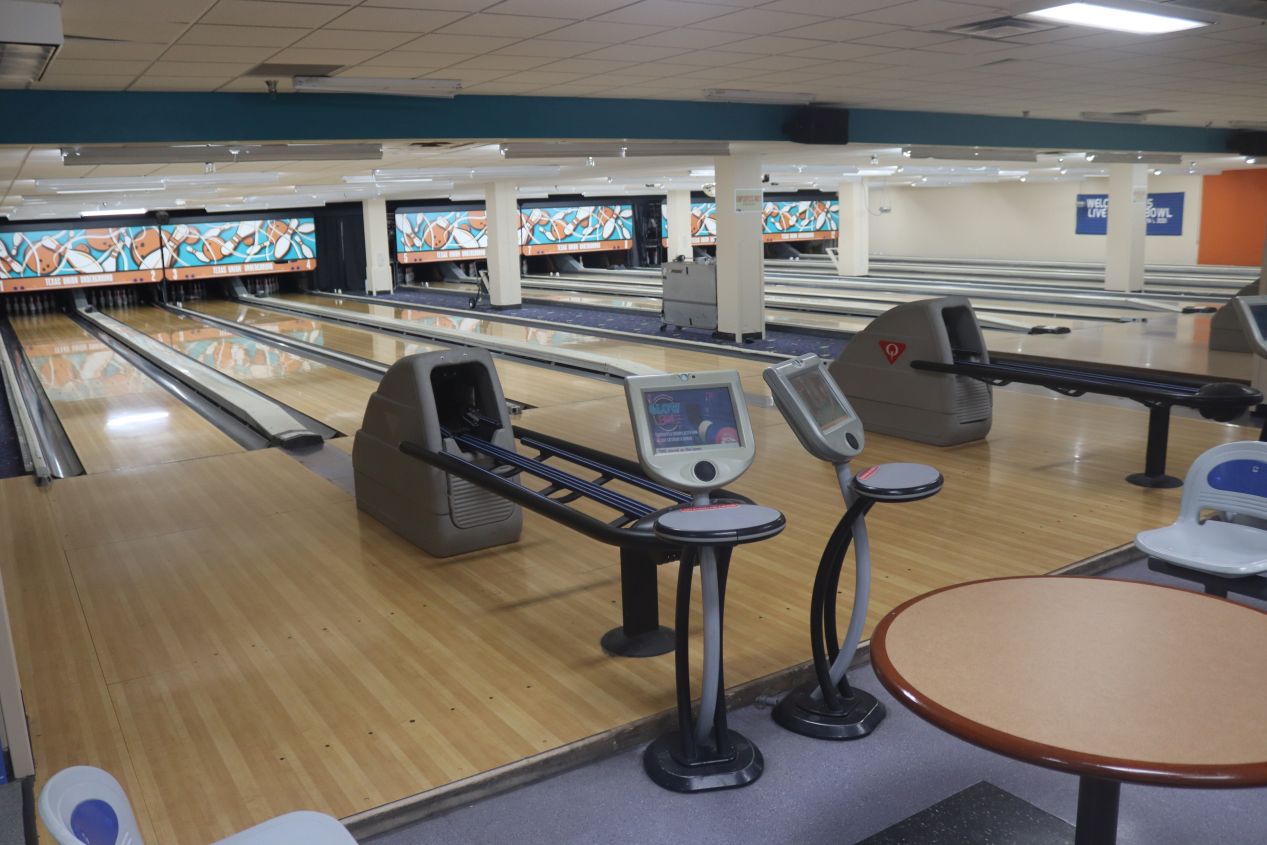


Next to the Main Building in the center of campus was the Texas Union where I headed next. The ground floor held the usual food options that I've found at student unions across the country; it was lunchtime when I visited and there was a huge line of students waiting to eat at the Panda Express. The basement held a recreational area full of pool tables and bowling alleys which were going unused at the moment. The upper floors of the Union were much fancier with these quiet study areas featuring lots of wood paneling. They were quite a contrast to the loud, bustling crowds down below and I think this is the kind of place that I would have enjoyed back when I was in my university days. I felt awkward taking pictures and didn't stay long to avoid bothering these people.

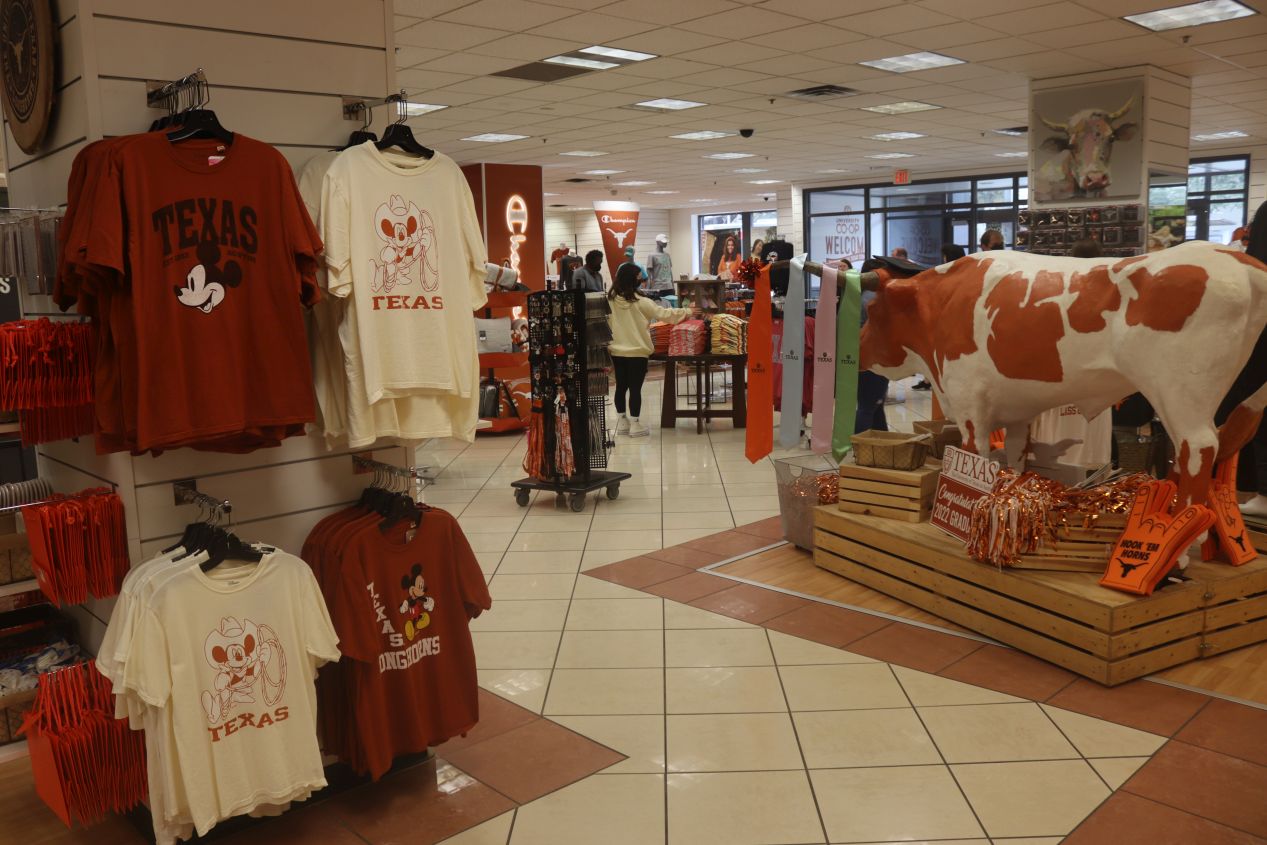


I was a bit surprised not to find a huge bookstore selling all kinds of UT merchandise located within the Texas Union. Instead I found that place located across Guadalupe Street at the Co-Op, just off the official campus grounds and situated on a busy street full of eateries catering to university students. This was the place where visitors could purchase anything under the sun with a Longhorns logo and the burnt orange coloring of the university; I noticed that they were still selling #35 Kevin Durant jerseys a good fifteen years after he had briefly played at Texas. There was even a model of Bevo here next to signs congratulating the upcoming Class of 2022 and "Hook 'Em Horns" foam fingers. Speaking of graduation stuff, I made sure to get a picture of the doctoral robes worn by UT graduates which could have been me if I'd chosen to attend this university. I can't say that I cared for those brown/orange robes though and this is one place where I don't think I'm being too biased in saying that the University of Maryland doctoral robes look better.

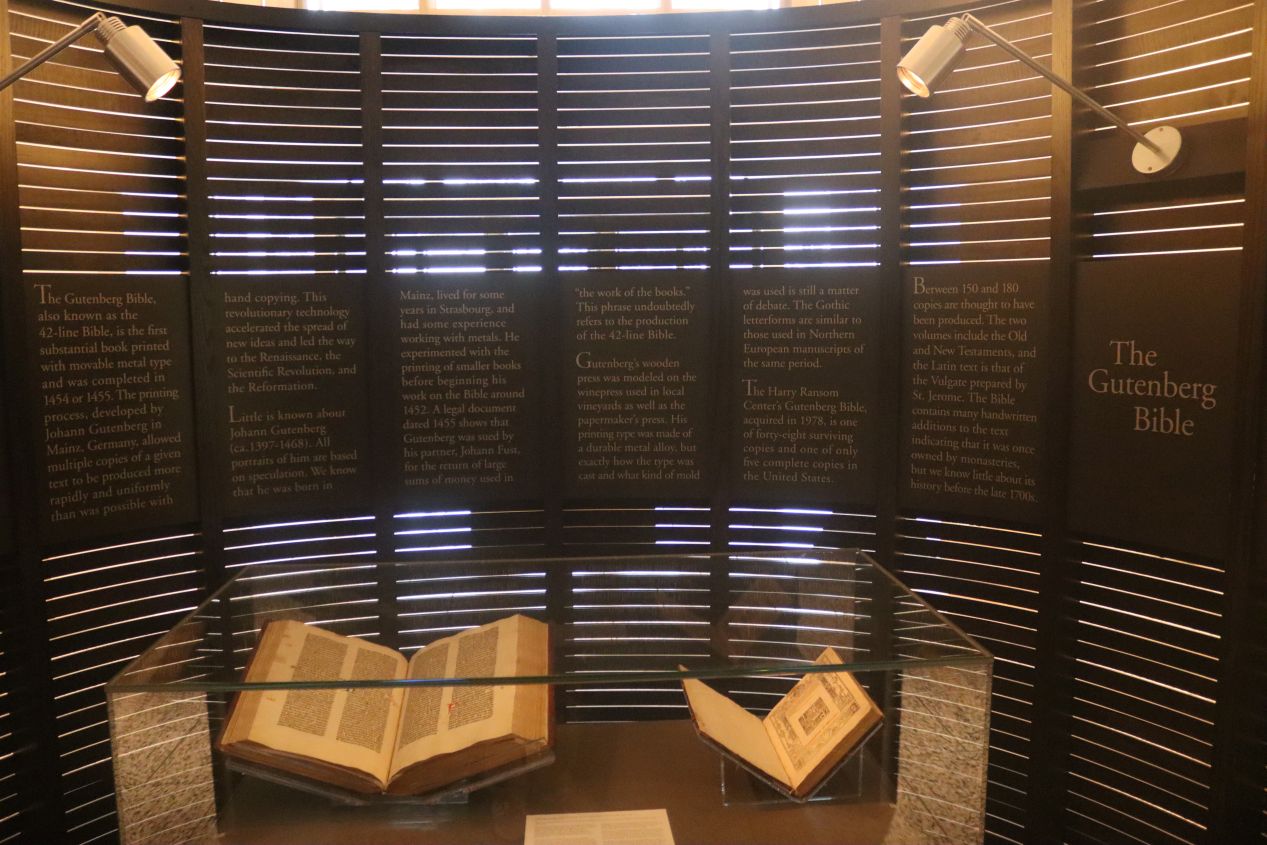


The last place that I stopped to visit on the UT campus was the Harry Ransom Center, an archive and museum that specializes in the collection of rare manuscripts. According to Wikipedia, the Ransom Center houses 36 million literary manuscripts, one million rare books, five million photographs, and more than 100,000 works of art. The biggest highlights of the collection are an original Gutenberg Bible (one of only 21 complete copies still in existence) and Nicéphore Niépce's 1826 "View from the Window at Le Gras" which is supposed to be the oldest photograph ever taken. Both were on display in the exhibit space on the ground floor of the Ransom Center but the photograph was so opaque that I couldn't make out any details on the pewter plate used to capture the image. The Gutenberg Bible was much more impressive. At the time of my visit, the exhibit space was featuring a bunch of stuff about how several women helped make the publication of James Joyce's Ulysses a reality (which didn't interest me - I'm not a fan of Joyce) and a series of early modern texts from the 16th and 17th centuries. This was much more in my wheelhouse since I worked extensive with early modern sources during my graduate days. I particularly liked some of the maps and globes that the Ransom Center had on display from this period and would have happily gone through more sources beyond the handful they had publicly available in their museum space. This is mostly a place where scholars work and the exhibit area was relatively small.

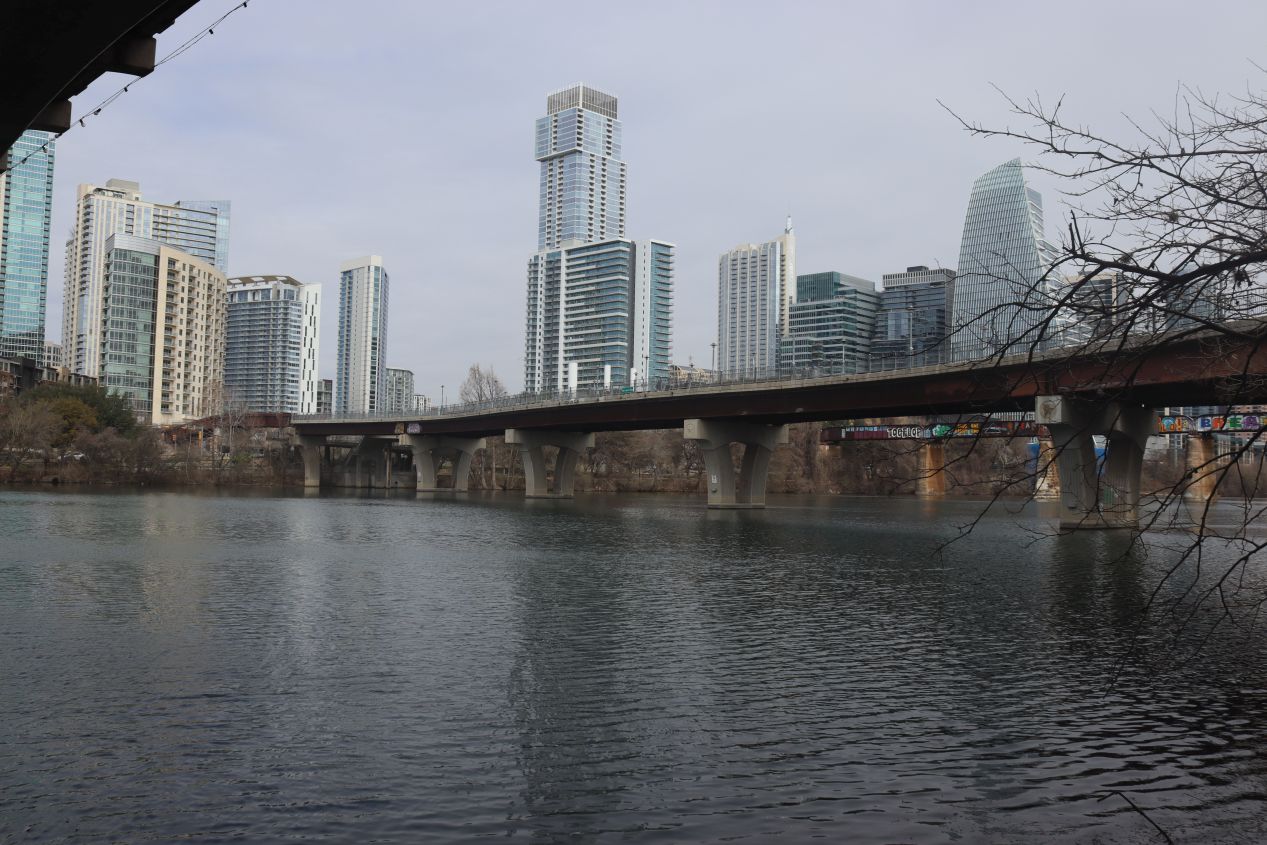


I grabbed a quick lunch after finishing up at the University of Texas, taking advantage of a Tuesday-only deal for 50 cent wings at a Wingstop next to the campus. From there it was a lengthy walk of about two miles down to the parks that follow along the Colorado River as it cuts through downtown Austin. Several of these parks are named after Lady Bird Johnson due to her involvement in the environmental and conservation movements along with her long association with the city of Austin. I took the first two of these pictures at the Pfluger Pedestrian Bridge looking north at the buildings in downtown Austin after having crossed the river to the south side. Then I followed a small offshoot of the Colorado River with the name of Barton Creek as it headed towards another one of the city's most famous attractions.

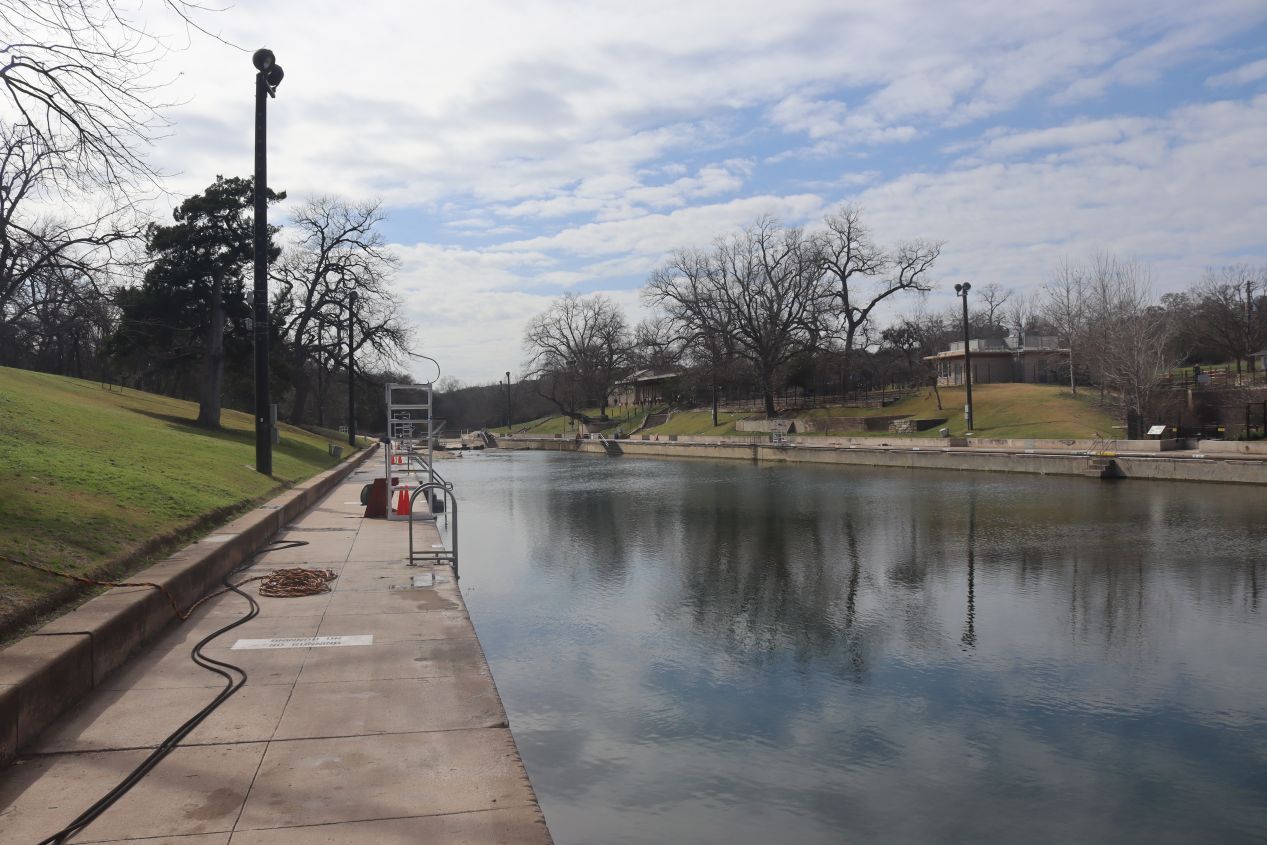


I was making my way to Barton Springs, a recreational outdoor swimming pool fed with water from nearby natural springs. Austinites have been swimming at Barton Springs since the 19th century and most of the current pool infrastructure dates from the 1920s. Barton Springs is normally open from 5:00 AM to 10:00 PM daily and it's been a beloved outdoor space for the city's residents for generations. Unfortunately everything was shut down at Barton Springs when I arrived, probably because the staff was getting the place ready for a formal spring opening in mid-March. As a result I was only able to capture these guerilla-style photographs looking through the closed gates and peering over the fences from the surrounding woods. This is a place better visited in the summer months when it's packed with families seeking to escape the daytime heat. If I had known that everything was going to be shut down, I wouldn't have spent over an hour walking all the way out here!

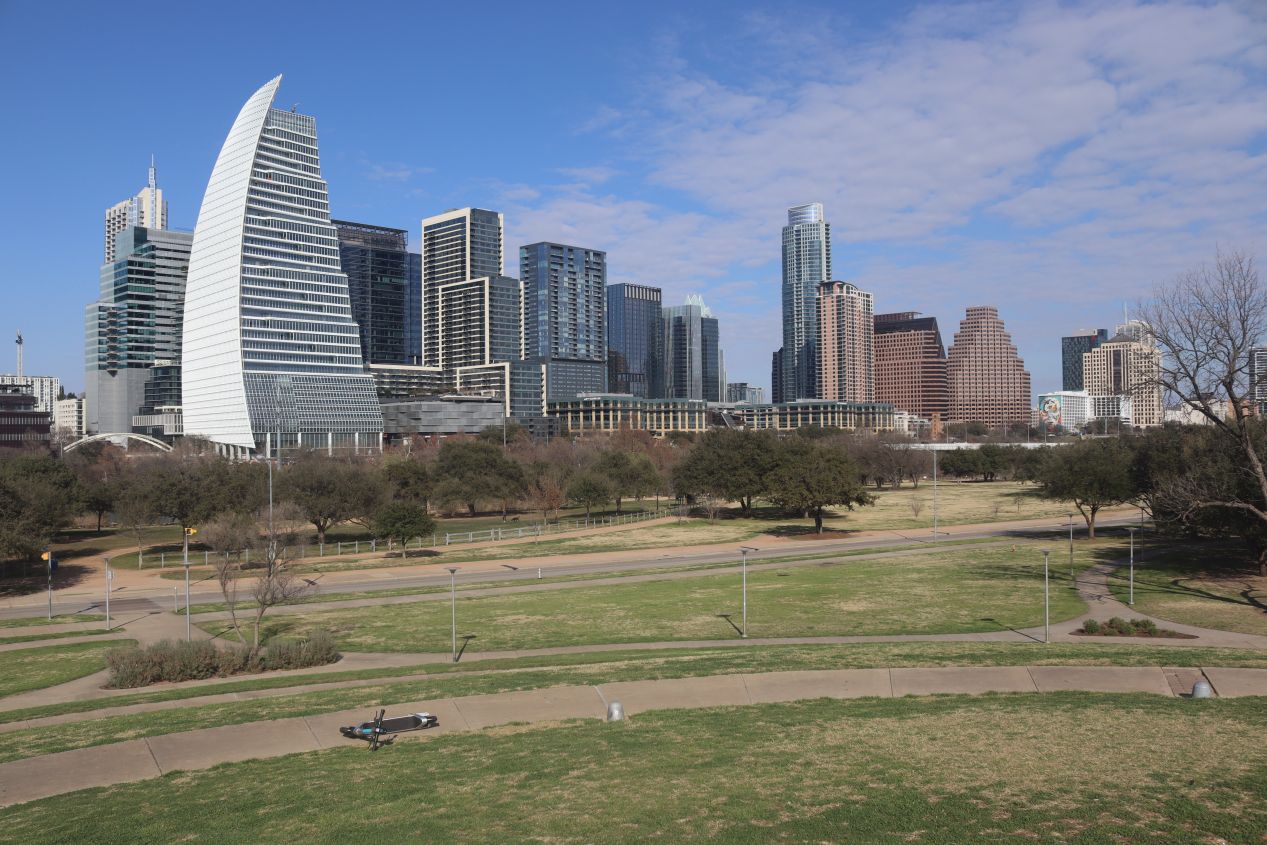


The good news was that the weather was finally starting to clear up and bring some sunshine into what had previously been a gloomy day. I was walking back in the general direction of our hotel along the south bank of the river, strolling along something named the Butler Hike and Bike Trail that followed the water's edge. This was a lovely public space and there were lots of other people jogging or walking their dogs in the afternoon sunlight. Soon I reached a little mound named the Doug Sahm Hill Summit where I enjoyed some nice views of the downtown skyline and the surrounding fields on the south bank. This is the part of Austin that hosts an indoor events center and a theatre for the performing arts. There was even a statue along the water dedicated to local guitarist Stevie Ray Vaughan. These outdoor spaces are one of the reasons why Austin has the reputation of being a great city to live in; people like almost everything except the terrible summer heat.

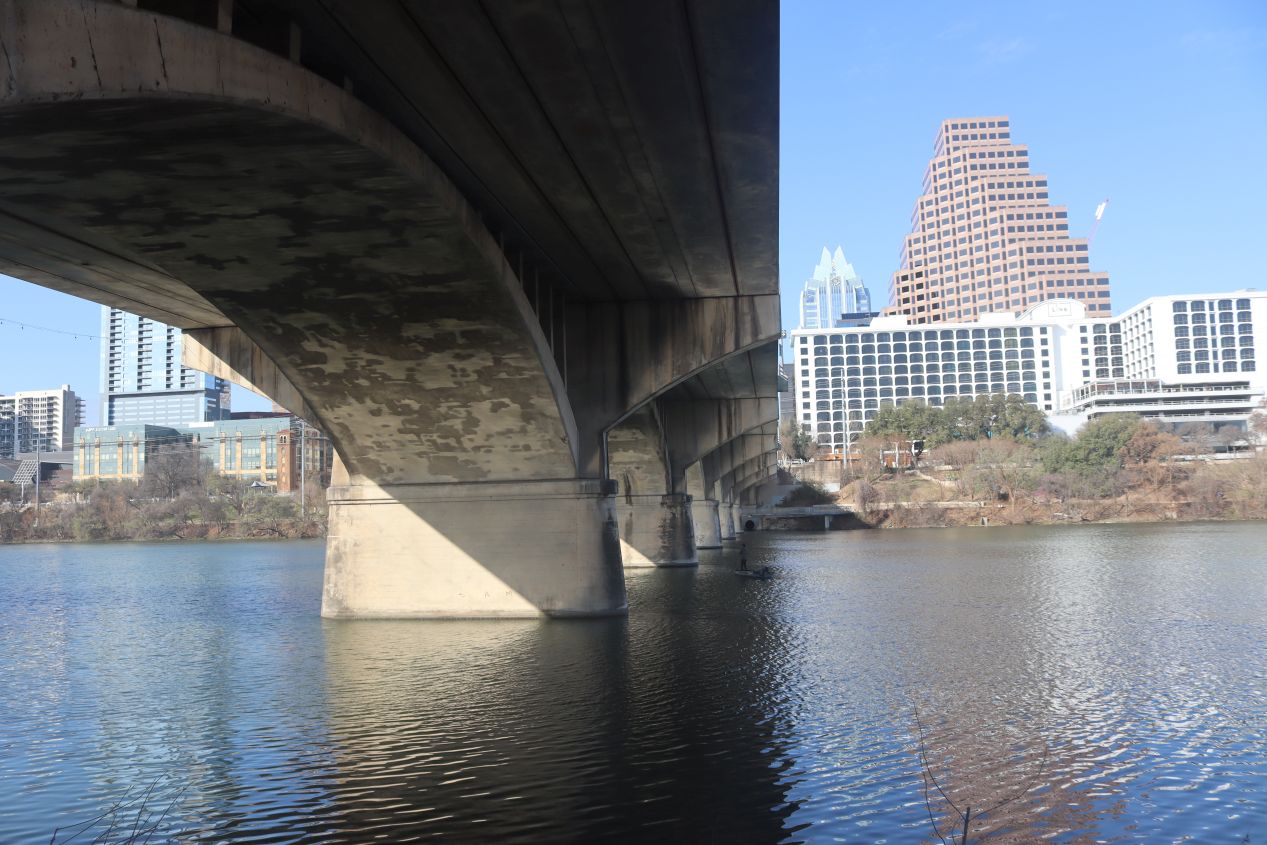


Eventually I reached the Ann Richards Congress Avenue Bridge, home to an unexpected kind of Austin resident. The underside of the bridge turns out to be the home of the world's largest urban bat colony made up of Mexican free-tailed bats. The animals are migratory and spend winters in Mexico but return each year in the spring and can reach well over a million in number. The bats reside beneath the road deck in gaps between the concrete component structures and I spotted several signs warning visitors not to touch or disturb the bats. At one time the Congress Avenue Bridge bats were widely unpopular and the colony was at risk of extermination; a public education campaign that started in the 1980s changed how people viewed the bats and they have since become a beloved part of the city. There are several different boat tours that take visitors out on the river to watch the bats emerge each evening and tons of bat-related merchandise for sale across the city. This wasn't a great time of year to view the bats since most of them were still migrating north from Mexico and we didn't end up having an opportunity to watch them on this trip. Here's a picture of what it looks like when they stream out from under the bridge in the warm summer months.

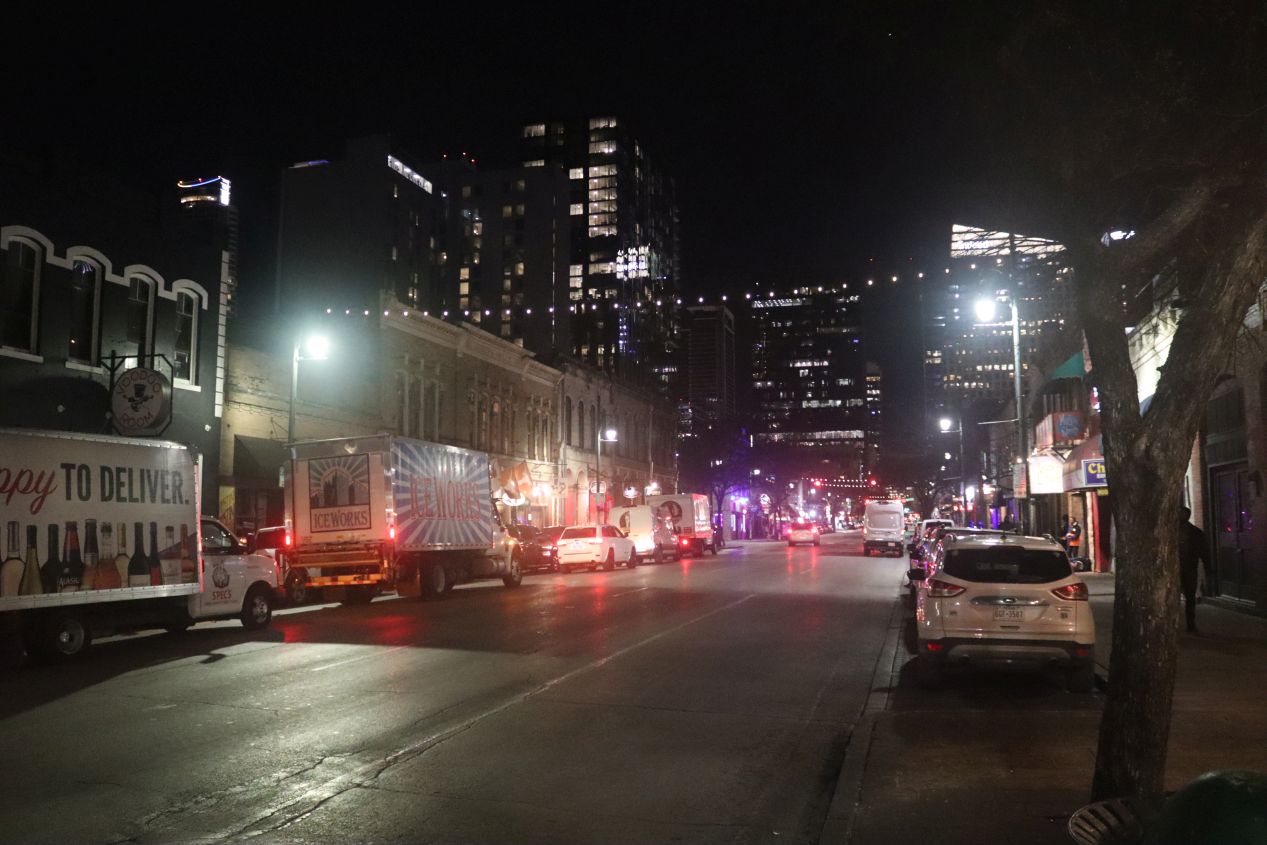


That was the conclusion to my afternoon tourism as I walked north across the bridge and made my way back to the hotel. South by Southwest was finishing up for the day by the time that I returned, and we went out to get dinner afterwards at a Mexican restaurant on Sixth Street named the Iron Cactus, visible in the first picture above. Before we retired for the night, I decided to spent half an hour walking through downtown Austin to capture a few more pictures and see how everything looked different after dark. Sixth Street was much busier at 8:00 PM as compared with 8:00 AM, even here outside of the main tourist season, with its bars and restaurants open for business and lots of loud music spilling out of their front doors. I passed by the Driskill again which was lit up for the evening and welcoming the arrival of new guests for the conference. From there I turned onto Congress Avenue and headed back to the riverfront again:

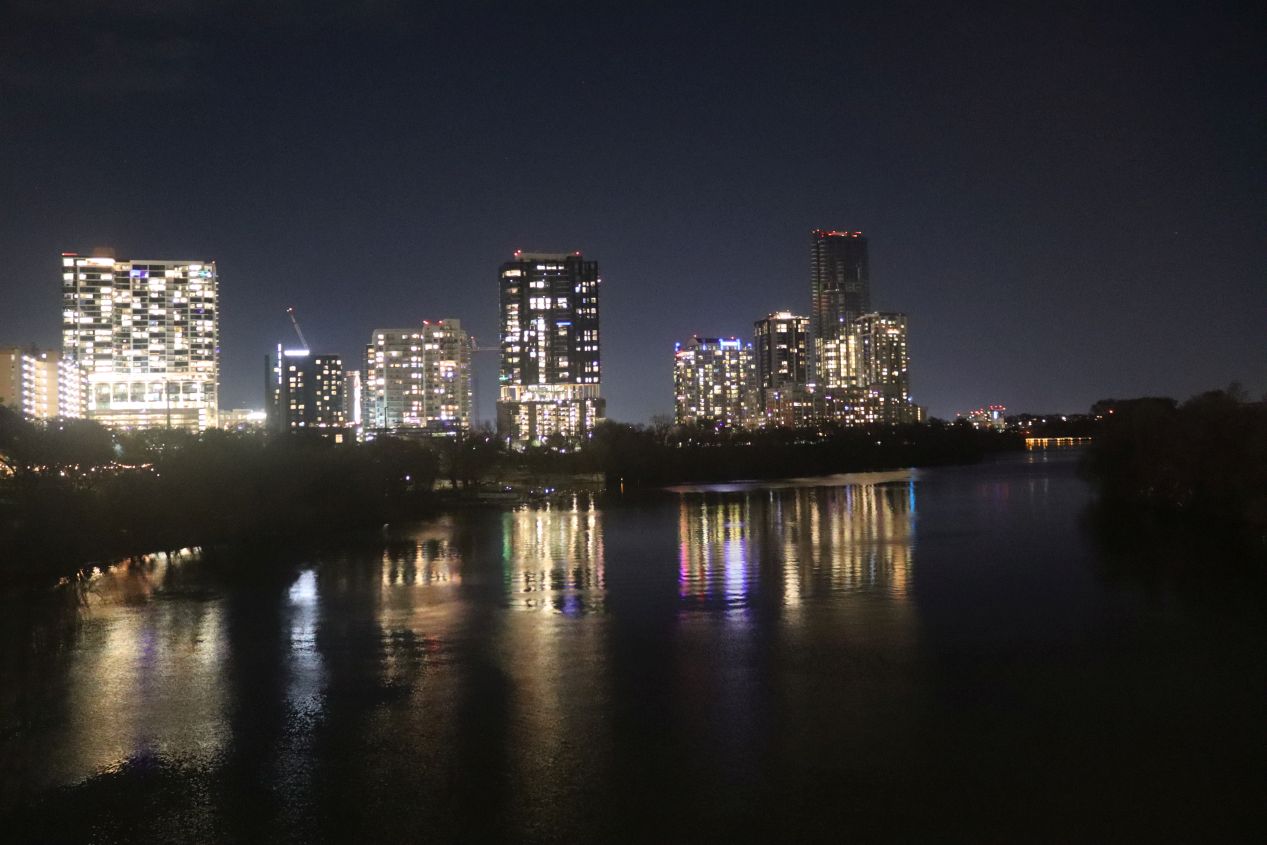


These were some final nighttime images taken from the middle of the bridge spanning across the river. The bright lights of the new skyscrapers were dimly reflected in the dark waters of the river below and the city felt peaceful and quiet in the chilly evening air. I could see the Texas State Capitol building off in the distance to the north and a series of hotels lining the banks of the river as it winded off to the east. It was a fine way to close out a busy day of sightseeing across the city, and even if a number of places had been closed or less crowded than they would have been during the summer months, I still felt that I'd been able to cover a lot of ground for my single day spent in Austin. This was a short trip as Liz was only in attendance at South by Southwest for two days and we flew back to our home the following morning. I'm glad that I had this opportunity to visit Austin and wouldn't mind coming back again someday!



